 16Likes 16Likes
 |
|

28 Apr 2012
|
|
Registered Users
New on the HUBB
|
|
Join Date: Apr 2012
Location: China
Posts: 1
|
|
|
amazing report, awesome picture.
|

15 May 2012
|
|
Registered Users
Veteran HUBBer
|
|
Join Date: Mar 2010
Location: Bucharest, Romania
Posts: 117
|
|
|
Edge of Africa
Cape Town - Cape Agulhas 01- 10/04

The first men who ventured into the southern seas were spellbound by the wild beauty of the peninsula: flowers, herbs, woods, elephants, hippos. Since the advent of pastoralists, the original peninsular Khoi vanished, the wild herds were wiped out and much of the endemic vegetation has been uprooted to make place for industrial and residential developments. But the city, one of the world's few, like Rio and Hong Kong, that enjoy an exceptional geography, has kept its charm. We almost grew roots in Cape Town. For many over-landers, it represents the glorious finale of a arduous journey down. For us southern hemisphere's most important container port meant more business than pleasure, a much needed logistic base camp to sort our stuff out. We tried to organize as best as we could our journey ahead, couldn't get any temp jobs though, not could we find sponsors, fix our leaking tent or patch the aluminum pannier turned harmonica in the Congo. But southern winter, with rain and cold winds, was an extra incentive to suck it up and get moving. Which we did, not before enjoying with James a final wine and cheese at the Fairview Estate, one of the many Old World-like vineyards in Stellenbosch.
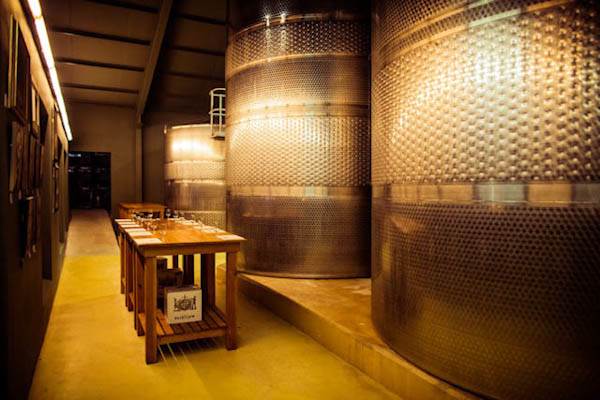
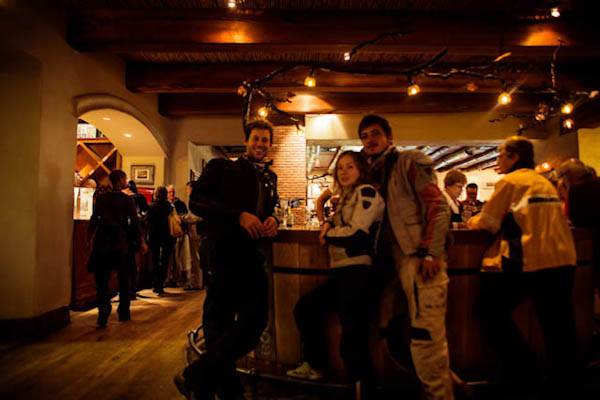

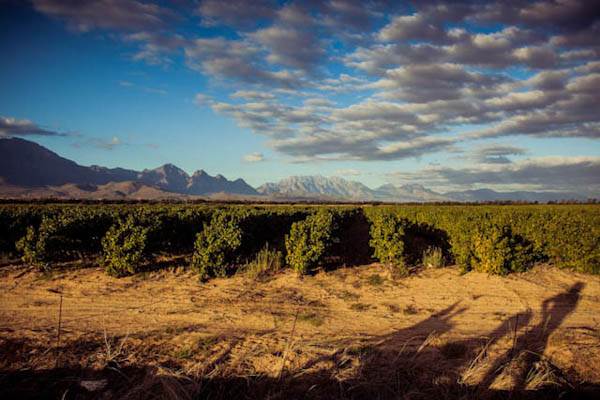
A rich soil, a gentle climate and a permissive law, that allows mixing grape varieties and techniques means that even the cheap supermarket wines are seldom not very good in South Africa. After the gourmet hour, we took a fair well ride in the crisp sunset through Bainskloof Pass.
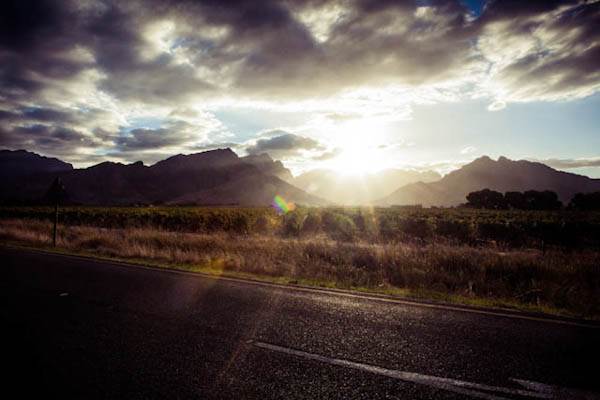
We took our last breakfast in Cape Town with Charl, who was keeping another ace in his sleeve: the best eggs Benedict in town.
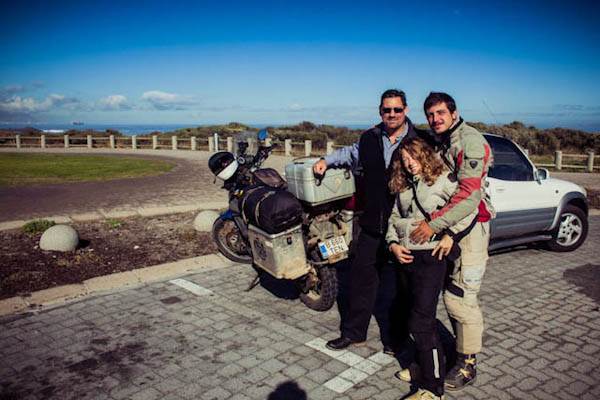
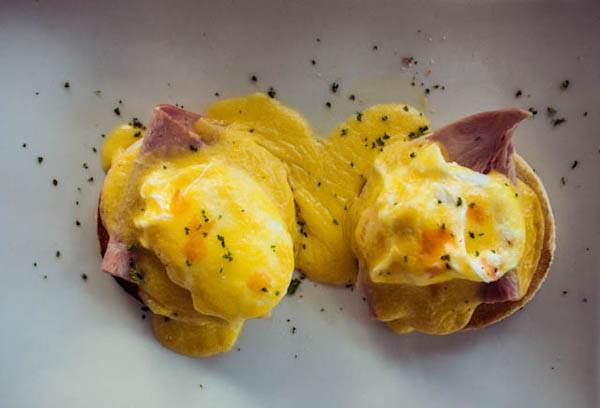
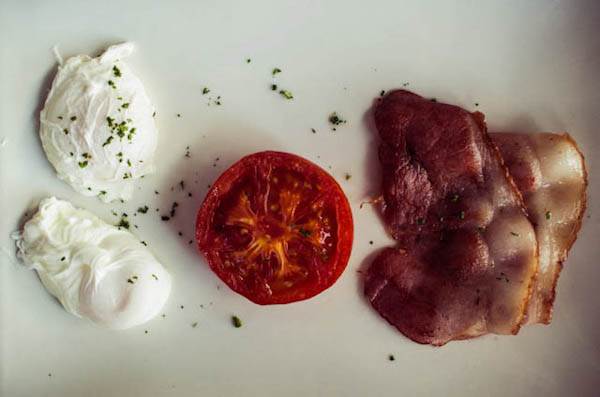
When we were shopping for a shared room to rent in Cape Town, a guy had mentioned Clarence Drive as being more stunning than Chapman's Peak. From Gordon Bay to Hermanus and up Gansbaai we finally had the chance to see that for ourselves. The Indian waters are strikingly blue, the shores gently curved into successive gulfs, while the perfectly smooth tar keeps the adrenaline pumping.

Now and then we stopped to listen to the ocean and count clouds. Epicurean surfers were hanging out in the frothy surf and life seemed beautiful.

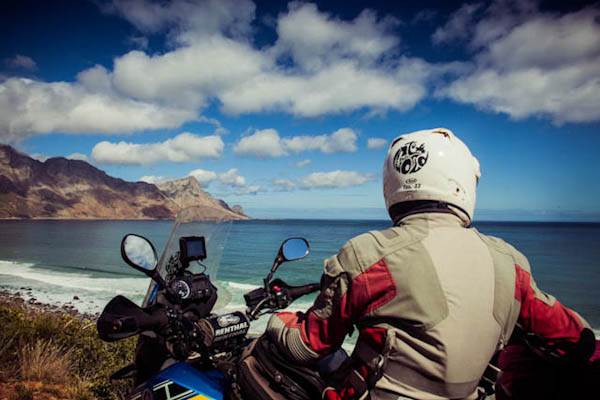
We continued on the R44 to Gansbaai, where we lunched on fish & chips. We were bored of tarmac and running out of time, so we cut it straight to our destination, across the Agulhas National Park. One would expect a dramatic view in such a landmark spot, but the shores of Cape Agulhas are flat and a simple wooden path leads to the famous sign.

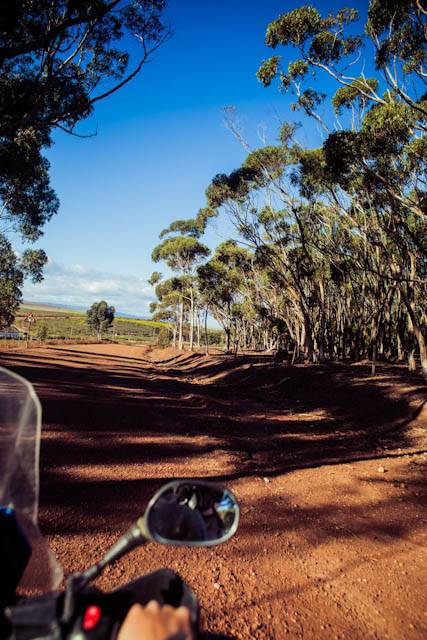
We have been marching to this point for months, and once there, we felt joy, but also butterflies in our stomachs. Where the traveller imagines an extraordinary scene, the earth is flat, modestly dotted with juicy flowers, and the waves rhythmically pound into the indifferent shore.
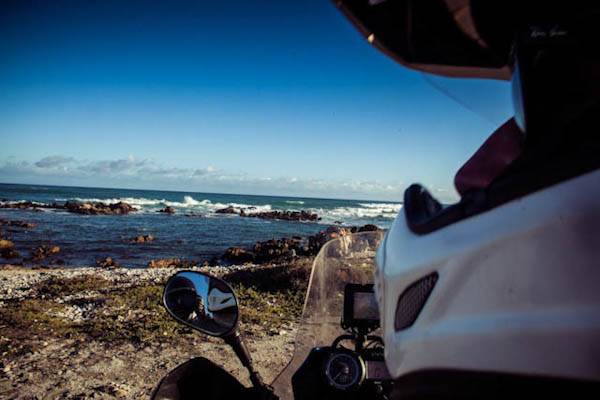

We obliged for the mandatory photo at the Cape Agulhas, but gravitation is kind of weird around here…
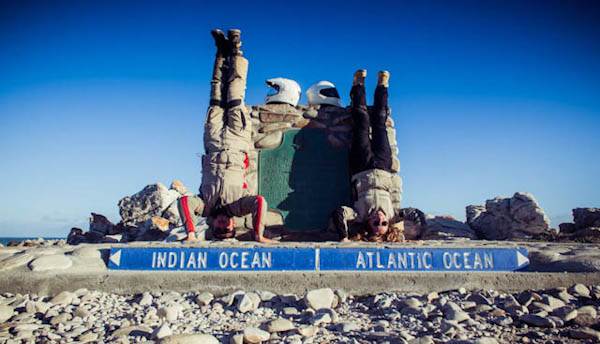
The end of a chapter, so many faces, places and stories that have become memories we miss. From now on, our journey will took us only north… at least for a while.

|

15 May 2012
|
|
Registered Users
Veteran HUBBer
|
|
Join Date: Mar 2010
Location: Bucharest, Romania
Posts: 117
|
|
|
The Swastica, The Ironman, The Metal Jockey and The Magician - Part I
Couchsurfing: Garden Route, Port Elizabeth, Somerset East 11 - 15/04
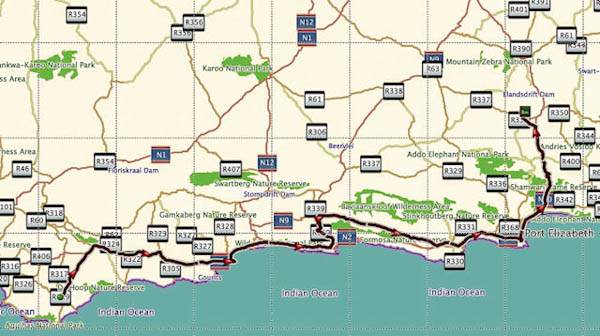

We had left from Cape Agulhas in good spirits, but at that time of the year the day was short and evenings too chilly for our summer gear. I had lost my gloves long time ago, in Windhoek, and my spare pair had been baked by desert heat to the point of being unwearable, so my hands were freezing. Everybody had been saying how wild-camping was unsafe in South Africa, but the fact of the matter was that had not seen a single unfenced spot all day. We did try reluctantly a few campsites, none was open though, high season now over. We stumbled upon some hotel that was 60 euros for two beds in a dorm. When we arrived in Bredasdorp it was already pitch black. We saw a couple of power bikes parked in front of what looked like a cute pub, The Pink Piano, so we figured we could go in, have a drink and ask locals for advice.
If you're not in the business of meeting quirky characters don't bother to couch surf in South Africa. Here one must leave their prejudices at the door and step in expecting nothing. Which is what we did, and we were rewarded with hospitality, sense of humor and some of the most unusual encounters. The cocktail nation of South Africa may lack in the peaceful cohabitation department and may not be the jolliest around, but this very polarized structure has allowed all sorts of social specializations that are quite an eye opener for someone coming from a place like Romania. Not being judgmental is hard, so let's go.
In Cape Town we were hosted by a jewish guy who works in the film industry and his romanian girlfriend, then by christian Afrikaners, who couldn't be more different from the cocaine addicts we were warned about. The Cape Town motorcycling community provided the fun, the information and the rides into the veld. 300 kays from the Mother Town, in Bredasdorp's Pink Piano pub, we had a bad feeling that it was the right place to ask for directions. Three biker dudes and a goth chick were dressed head to toe in black leathers, sporting army style haircuts and swastikas pins. We sipped our tea and  while the guys debated our situation in Afrikaans. Nothing good could come out if this, we thought, but we were about to be proven wrong. The guy sitting right next to us at the counter put down the phone and offered us a wide smile; his wife had agreed to welcome us for the night at their place! JJ is a mechanic at a testing facility for the South African military aviation. His wife teaches English at a colored school, and they have two kids, a girl and a boy. We enjoyed each other's companies and stories so much, it was hard to put an end to the night. In the morning we exchanged contacts and regretfully said good-bye. Cheers, JJ!
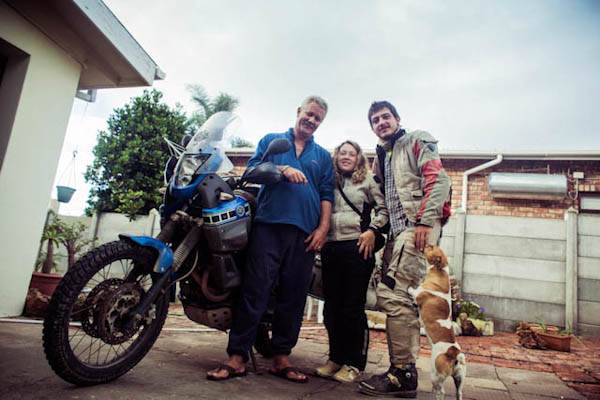
Midway between Ct and PE, on the East coast of SA, lies the scenic garne Route, named for its lush vegetation. Garden Route is hailed as one of world's best drives. Frankly, we couldn't see why: its basically a quite busy freeway running parallel to, but far from a section of the country's most beautiful coastline. The drive itself is not particularly thrilling, as the routes more a eco-tourism destination, for shopping, sunbathing and the odd celebrity spotting, a holidaymaker and the world's rich and famous paradise. It is a charming holiday area, not catering to the travelers on a show string, but to enjoy the beautiful views, the beaches and tranquil bays, one must leave the freeway and drive many kays to reach the resort towns. We had nor the time or the budget for this, so after a few off-road detours to smell the salty breeze and sink our eyes into the endless horizon we kind of got bored with the traffic.
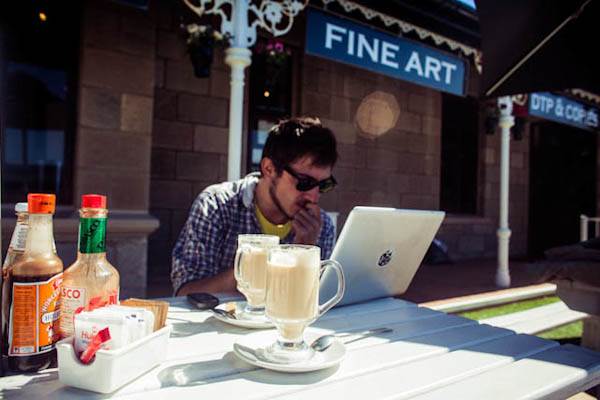
In 1488 Bartholomew Diaz was the first european to reach south African soil in Mossel Bay. We stopped there in a cute cafe owned by architects, for a latte and internet. Later we asked some locals where to sample the famous Mossel Bay wild oysters, but they were not even close to the ones we had in Walvis Bay! The seafood basket at the Sea Gipsy was brilliant though, if not very cheap.
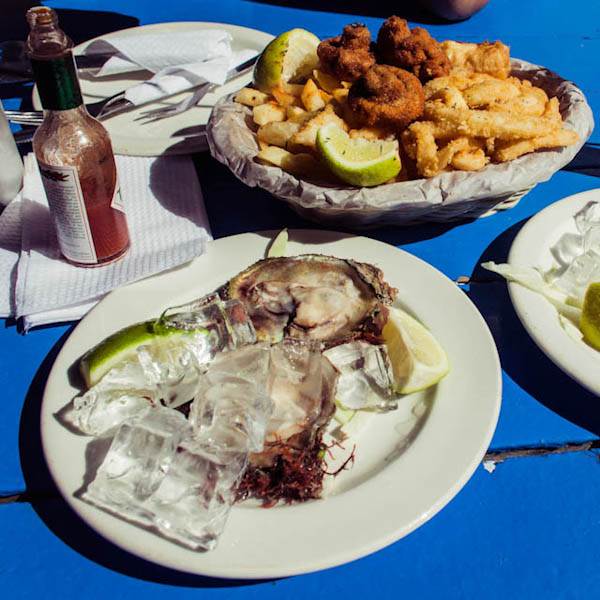
Garden Route, when it's not full of jeeps.
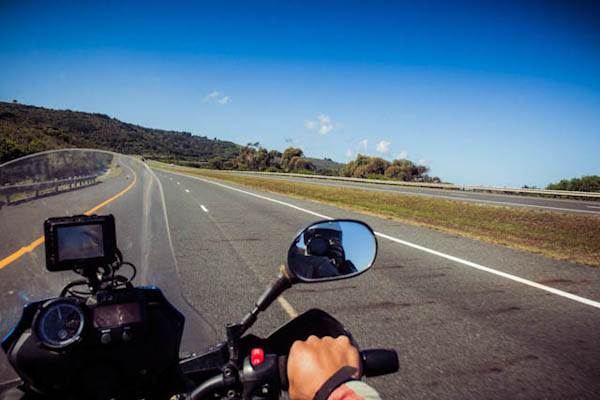
After Knysna we decided we had had enough, so we took a left towards Route 62, via Albert Pass. In a couple of kilometers we were again alone, riding on a superb gravel road that winded up rolling green mountains. For a while we remembered to take some shots of the stunning views and frigid waterfalls, but soon enough we were too spellbound to stop.



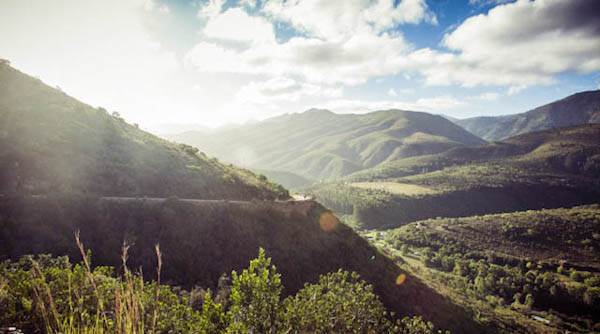
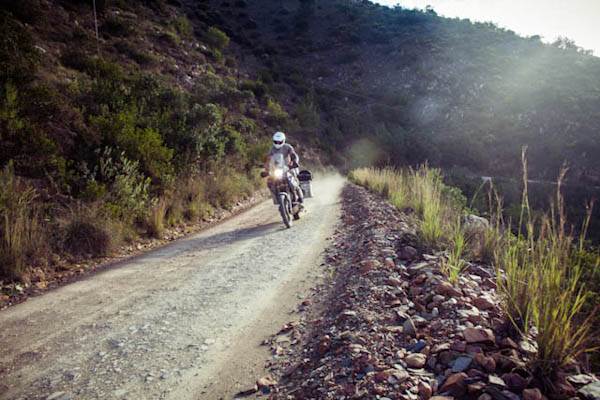
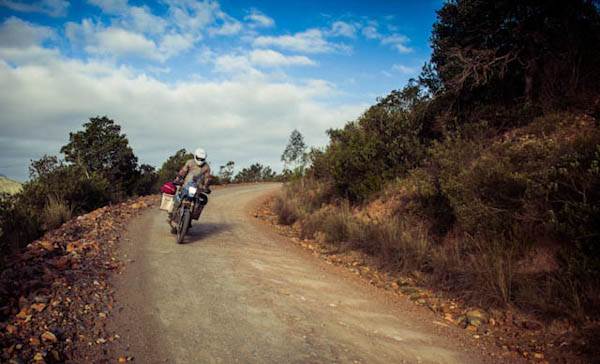
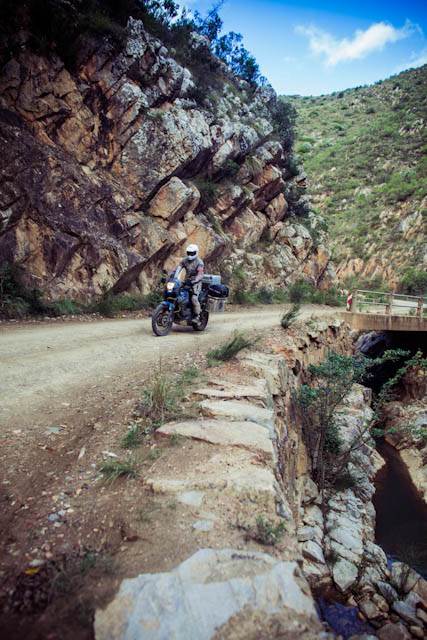
The road looked like that:
Once we hit the plateau again, we took Route 62 across the hilly countryside that cuts through several conservancies. It was already getting dark though, so unfortunately we didn't get to see much. At some lost filling station we bought petrol and some food.
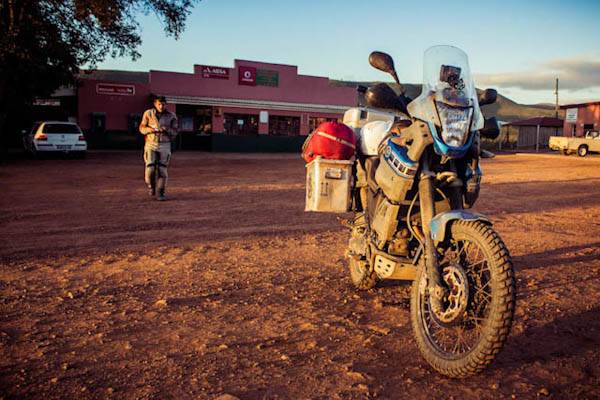
It was after 8 p.m. when we arrived at our host in Port Elizabeth. Bernard had been following our thread on advrider.com since last year. But this guy was an Ironman. If you are not familiar with what is the toughest and most grueling athletic competition in the world, let us give you a few details. The numbers alone defy description: 3,8 km open sea swim, 180 km cycling, 42,2 km run; world record is over 8 hours, cutoff time 17 hours. Bernard has done it twice, in little over 11 hours! He has been training his body and mind for a lifetime to beat what is generally accepted to be humanly possible. And yet, with this ironman schedule, he invited us in his life, and boy, what a man we discovered behind the iron!

Bernard & Sharmyn are quite the iron couple really: she has also done the competition, twice!
PE is the third largest port for cargo, built around the Bay of the Lagoon and the 1799 fort, but officially named after the arrival of the 1820 British settlers, their ships carried ashore through crashing surf and confronted by a desolate sweep of sand and the uncharted bushland behind that. Today PE is - together with Uitenhage area - the heart of the motor industry where the largest automobile manufacturers are headquartered. Also PE's Nelson Mandela Bay is the venue for Ironman South Africa. The wind swept beaches are perfect for an intimate picnic, so we grabbed some barbecued chicken and a bottle of Merlot and hit the dunes.
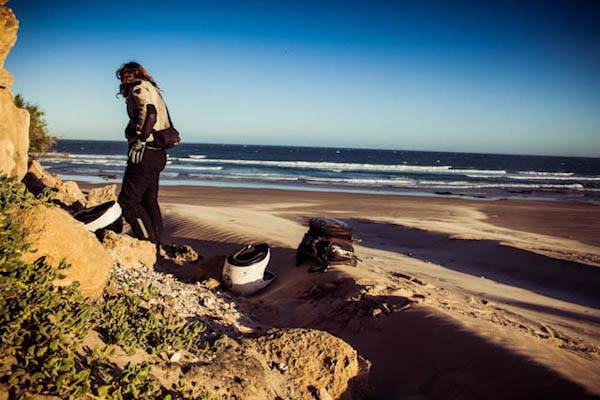

The few rustic Dutch town houses that survive have been refurbished as souvenir shops and info points.

Malls and recreational areas line the ocean. From this wifi connected cafe we could see street-side african art dealers selling generic carvings and jewelry called 'curios' since Zambia.
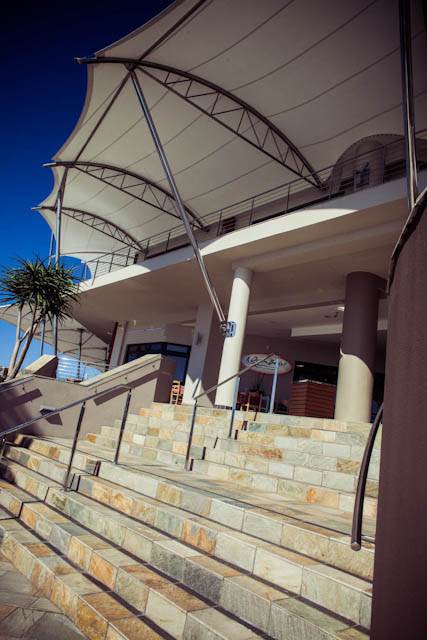
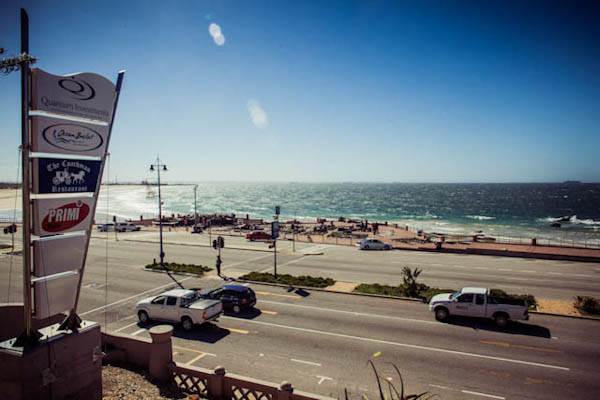
PE is nicknamed 'the friendly city', and rightfully so. Terry, an architect and his wife Dorianne had also been online with our travels for a while and were keen to meet and host us. We shared many stories over a lovely dinner, a far too short opportunity to get to know each other. Hoping that we would meet again, we left PE the next morning, as Bernard had made plans to braai at his father's farm near Somerset East. We hoped on our bikes: us on the Tenere, Bernard on his 80s BMW R1100 S, and 150 km and a prickly pear road side snack later, we were in front of the Avon Heights gate.
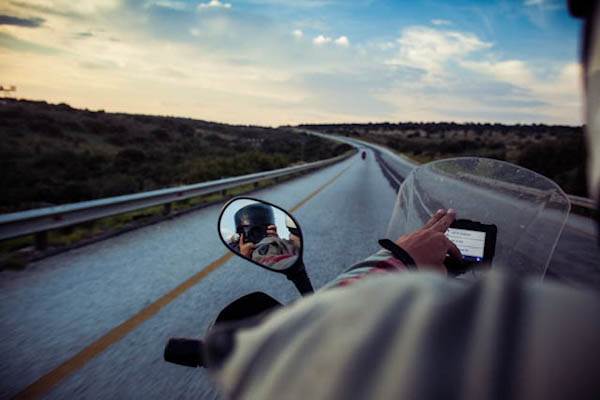


The country estate is a collection of charming buildings and family memories: pliable chairs manufactured in the 30s for the British army, old photographs, vintage furniture and a lovely rustic kitchen & stove


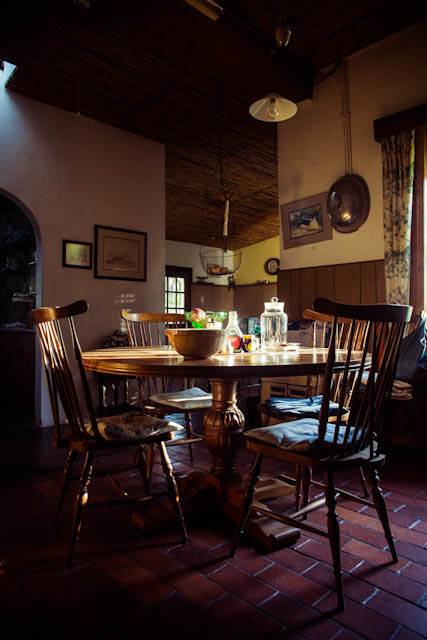




Among the family treasures, a 1932 Harley, from a 1137 pcs. lot specially designed for the British army. One day Bernard will bring this baby back to life.
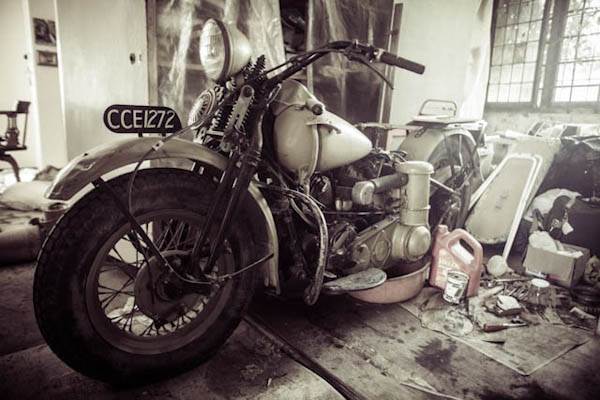
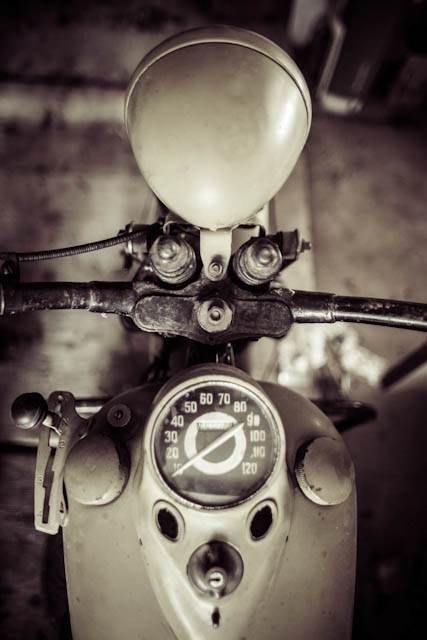
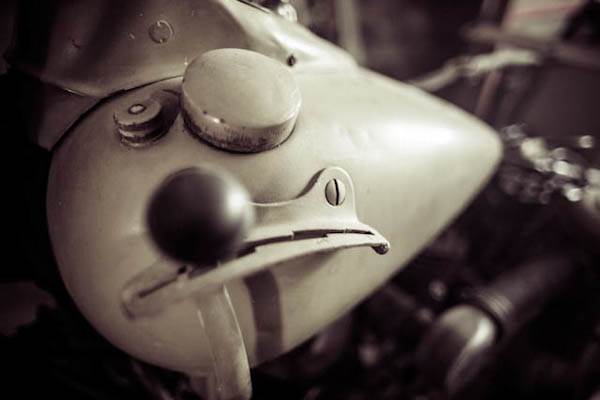

But the most precious secret on the estate is the waterfall that offers an astonishing background for braaing and swimming. We left our  s to cool in the crystal clear stream and made the fire.
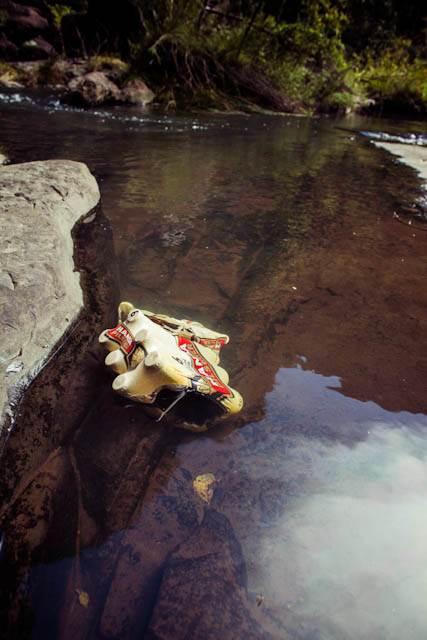

Our chilled gang
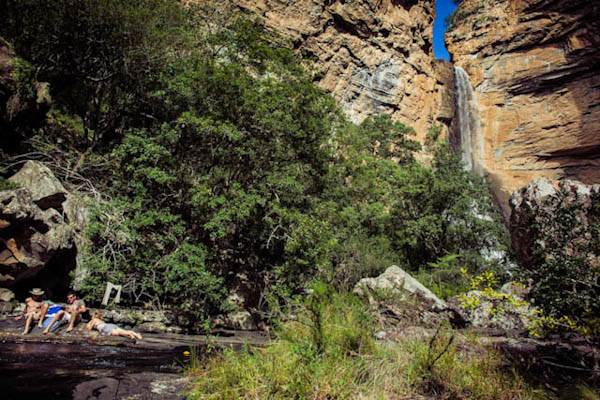
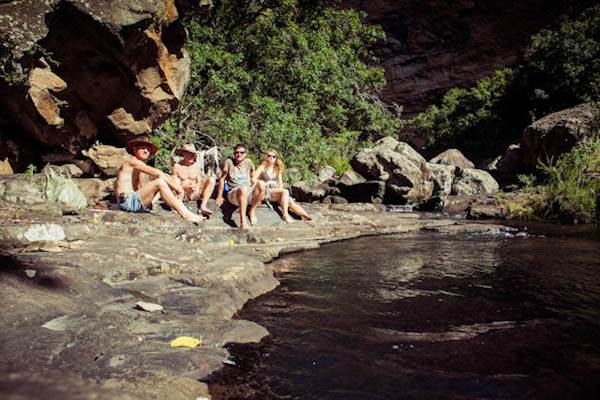
Avon Falls, an impressive sight at over 30 meters drop into several pools

All that is good must have an end though

In our case that meant a trip to the public hospital in Somerset East, where Bernard's dad had to get a few stitches after injuring himself onto a rock. The three hour wait in the hallway was quite interesting for us: this sketchy countryside hospital is not much worse that our Municipal facility in Bucharest!

|

22 May 2012
|
|
Registered Users
New on the HUBB
|
|
Join Date: Oct 2011
Location: Shell Beach, California
Posts: 10
|
|
|
Great trip, lots of photos. I love it. The picture of the tent on the beach with the shipwreck in the background should be entered in the HU photo contest. good luck.
Cheers
|

24 May 2012
|
|
Registered Users
Veteran HUBBer
|
|
Join Date: Mar 2010
Location: Bucharest, Romania
Posts: 117
|
|
|
The Swastica, The Ironman, The Metal Jockey and The Magician - Part II
Couchsurfing in East London & Durban 16 - 27/04
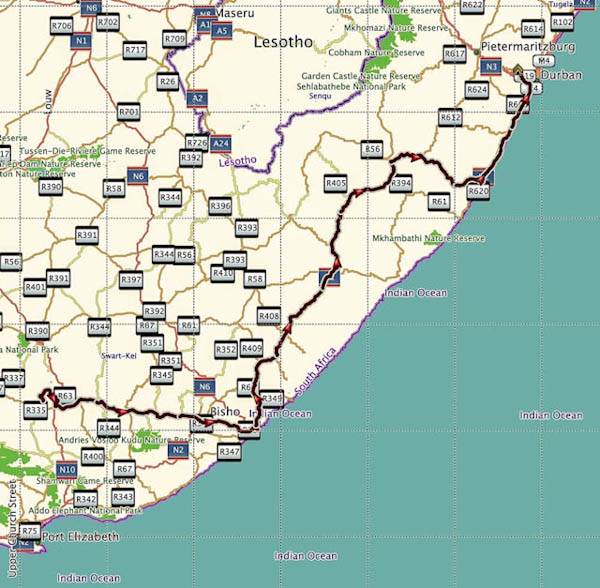
We left Avon Heights on a chilly morning, wearing almost everything that we've got. Across the mountain, then through some farmland and rocky trails, the ride to East London took the better part of the day. We reached tarmac again in the afternoon, stopped for another barbecued chicken and veggies lunch, then rolled into Gonubie.

This poor fluffy jackal had been hit by a car, even in this lost land

A puzzle of suburban homes for coloreds and blacks. Something that in South Africa is called 'township'.

Our big hearted main man from Cape Town had been the first to suggest we should meet a certain Metal Jockey. In PE it seem to be unanimously agreed that that was a good idea. So we popped in, our only chance to meet the legend. And the man, not to mention the wife and the kid, were up to the hype. Their ride reports on advrider are a must read. Our encounter was brief, but rich. These people are keeping it real. One day, if I'll have a kid of my own, I hope I'll have the balls to follow MJ's example and strap him or her to my bike and keep on being myself and do what I love best. Cheers guys for the braai and book!
We left late morning and on the way we decided we would push the 675 km to Durban. Lucky that the roads are top notch! We zoomed across the picturesque Transkei countryside, stalled by STOP sighs and roadworks. In the background the Drakensberg and Lesotho lured us to future adventures. The sun followed its prescribed route and as soon as it fell behind the horizon a cold wind gripped. We arrived in the Kloof suburb of Durban metropolitan area late at night, after passing by a familiar industrial sight. It had become a habit to reach our day's target by darkness.

In 1497 Vasco da Gama named this stretch of coast Natal (Nativity), having reached it on Christmas Day. Today Durban is the municipality of KwaZulu-Natal province, South Africa's biggest general cargo port and a mecca for holiday makers. We had come here invited by the most unlikely family that had accidentally learned about us. It looked like our couch surfing journey across South Africa would end among compatriots and now citizens of this land. Twenty years ago, Martin and Camelia gambled their life, left a newly freed of communism Romania, and won. Today they are living a comfortably if not wealthy life, which has allowed them to own property in exotic places and even indulge in the fantasy of overland travel. In a couple of days, they would be making the fantasy a 4x4 reality, taking the road from Cape Town to Cairo and Bucharest.
One of the coolest thing is that their son, Andy is a magician. A very young & talented one. To get your mind blown by some of the most new age magic numbers though, you must travel to Durban, before this guy will explode on the international scene.

Andy's sweetheart, the half woman, half fairy Candace, a massage therapist and healer.

We were received with Romanian meatball soup

Pork rind and red onion - another Romanian 'snack'

Romanians must be amongst the few whites who savor African maas or amassi (sour milk). Locals eat it with pap (maize meal similar to our polenta).

Audrey, the maid. She rents a room close to Kloof for 350 rand/month (about 35 euros).

Durban has a lot to offer: bustling city life, mild beaches, great surf, hiking trails in the Kloof Gorge and a heap of pleasant cafes along Florida Road.









Atmosfera urbana



A funky way to recycle: making lamps out of discarded milk bottles

The new football stadium, built for the 2010 World Cup




The Scientologists couldn't miss to have a share of the pie

South African breweries are world's biggest.

While sorting our shit out and gearing up for the continuation of Into The World we had an attempt to do Sani Pass on a light set up, with just the tent and mattresses strapped to the bike. Even if we took the tarred road to Sani, the ride was great, the green mountains stretching forever.



Epic fail. 50 km before the border I noticed that the back Heidenau had been delaminating and soon a big piece of rubber fell off. We though we would give it a go, but at the border we decided it was too risky to head into Lesotho like that. Figure for yourselves:

So we returned to Durban, kinda pissed, even if the ride down was fantastic.






We would definitely give this place another shot


We were lucky to return to the city: the guys at Bike Gear in PE were fast in sourcing us a free replacement tyre. A quick visit to Gear Up in Umhlanga was all it took. We couldn't find another Heidenau, so, taking into consideration the state of the roads up the East coast, we decided for a Michelin Anakee 2. Hopefully we are not sacrifing our love for off-roading in vain and this tyre will last to Europe.


But a Travellers' life is the road, so off we went. Good bye Martin & Camelia and safe travels along the East coast of Africa!

|

24 May 2012
|
|
Registered Users
Veteran HUBBer
|
|
Join Date: Mar 2010
Location: Bucharest, Romania
Posts: 117
|
|
|
The Swastica, The Ironman, The Metal Jockey and The Magician - Part II
Couchsurfing in East London & Durban 16 - 27/04

We left Avon Heights on a chilly morning, wearing almost everything that we've got. Across the mountain, then through some farmland and rocky trails, the ride to East London took the better part of the day. We reached tarmac again in the afternoon, stopped for another barbecued chicken and veggies lunch, then rolled into Gonubie.

This poor fluffy jackal had been hit by a car, even in this lost land

A puzzle of suburban homes for coloreds and blacks. Something that in South Africa is called 'township'.

Our big hearted main man from Cape Town had been the first to suggest we should meet a certain Metal Jockey. In PE it seem to be unanimously agreed that that was a good idea. So we popped in, our only chance to meet the legend. And the man, not to mention the wife and the kid, were up to the hype. Their ride reports on advrider are a must read. Our encounter was brief, but rich. These people are keeping it real. One day, if I'll have a kid of my own, I hope I'll have the balls to follow MJ's example and strap him or her to my bike and keep on being myself and do what I love best. Cheers guys for the braai and book!
We left late morning and on the way we decided we would push the 675 km to Durban. Lucky that the roads are top notch! We zoomed across the picturesque Transkei countryside, stalled by STOP sighs and roadworks. In the background the Drakensberg and Lesotho lured us to future adventures. The sun followed its prescribed route and as soon as it fell behind the horizon a cold wind gripped. We arrived in the Kloof suburb of Durban metropolitan area late at night, after passing by a familiar industrial sight. It had become a habit to reach our day's target by darkness.

In 1497 Vasco da Gama named this stretch of coast Natal (Nativity), having reached it on Christmas Day. Today Durban is the municipality of KwaZulu-Natal province, South Africa's biggest general cargo port and a mecca for holiday makers. We had come here invited by the most unlikely family that had accidentally learned about us. It looked like our couch surfing journey across South Africa would end among compatriots and now citizens of this land. Twenty years ago, Martin and Camelia gambled their life, left a newly freed of communism Romania, and won. Today they are living a comfortably if not wealthy life, which has allowed them to own property in exotic places and even indulge in the fantasy of overland travel. In a couple of days, they would be making the fantasy a 4x4 reality, taking the road from Cape Town to Cairo and Bucharest.
One of the coolest thing is that their son, Andy is a magician. A very young & talented one. To get your mind blown by some of the most new age magic numbers though, you must travel to Durban, before this guy will explode on the international scene.

Andy's sweetheart, the half woman, half fairy Candace, a massage therapist and healer.

We were received with Romanian meatball soup

Pork rind and red onion - another Romanian 'snack'

Romanians must be amongst the few whites who savor African maas or amassi (sour milk). Locals eat it with pap (maize meal similar to our polenta).

Audrey, the maid. She rents a room close to Kloof for 350 rand/month (about 35 euros).

Durban has a lot to offer: bustling city life, mild beaches, great surf, hiking trails in the Kloof Gorge and a heap of pleasant cafes along Florida Road.









Atmosfera urbana



A funky way to recycle: making lamps out of discarded milk bottles

The new football stadium, built for the 2010 World Cup




The Scientologists couldn't miss to have a share of the pie

South African breweries are world's biggest.

While sorting our shit out and gearing up for the continuation of Into The World we had an attempt to do Sani Pass on a light set up, with just the tent and mattresses strapped to the bike. Even if we took the tarred road to Sani, the ride was great, the green mountains stretching forever.



Epic fail. 50 km before the border I noticed that the back Heidenau had been delaminating and soon a big piece of rubber fell off. We though we would give it a go, but at the border we decided it was too risky to head into Lesotho like that. Figure for yourselves:

So we returned to Durban, kinda pissed, even if the ride down was fantastic.






We would definitely give this place another shot


We were lucky to return to the city: the guys at Bike Gear in PE were fast in sourcing us a free replacement tyre. A quick visit to Gear Up in Umhlanga was all it took. We couldn't find another Heidenau, so, taking into consideration the state of the roads up the East coast, we decided for a Michelin Anakee 2. Hopefully we are not sacrifing our love for off-roading in vain and this tyre will last to Europe.


But a Travellers' life is the road, so off we went. Good bye Martin & Camelia and safe travels along the East coast of Africa!

|

25 May 2012
|
|
Registered Users
Veteran HUBBer
|
|
Join Date: Mar 2010
Location: Bucharest, Romania
Posts: 117
|
|
|
We do Lesotho

Landlocked Lesotho (which translates roughly into the land of the people who speak Sesotho) is the only independent state in the world that lies entirely above the altitude of 1,000 metres (3,281 ft). Its lowest point of 1,400 metres (4,593 ft) is the world's highest. The kingdom's geological exuberance is possible thanks to massive tectonic events, that left the land disfigured by a jumbled mass of mineral scar tissue, peaking over 3000 meters. The most popular entrance to the kingdom is via an off-road legend, Sani Pass. This was to be our second attempt to tackle it, after having to forfeit with a faulty tyre. This time would be different: fully loaded bike & gear and on a road oriented back tyre, but what the hell!
Tipped by John @ Gear Up Umhlanga, we took a different, more scenic route, via Hella Hella Pass. The brisk morning and the empty bends cheered us up.

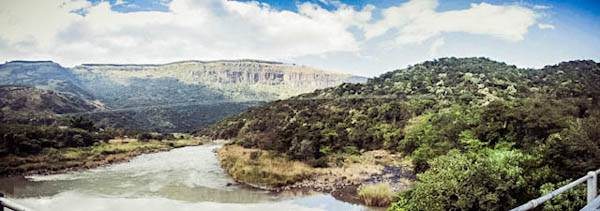
The place was just as stunning as we remembered it to be. Rolling mountains, cool springs, rocky steep trail. The wind though was another ball game: it was blowing hard this time, downhill.



The Sani Pass is as beautiful as they say it is, it's not the hype, it' s an addiction. Many succumb to it. As it was the 27th of April, so public holiday in SA, celebrating the first multi-racial democratic elections, the place was swarming with four-wheelers and bikes. Many 1200 GS and enduros, some of the guys visibly enjoying the ride more than me, on light set ups and full taps all the way!



Our beef was with the wind: blowing so hard that several times I was about to drop down on the loose rocks. It was a bit unnerving having the tour operators' 4x4s rumble and come past the bikers (and us) on the steep bends, clearly less affected by the strong winds. About 2 km before Sani we met a biker who was catching up his breath after the descent and kept worrying about his mates who had already taken a couple of tumbles and were lagging somewhere behind.

'I'm going to walk a bit" Ana said, determined to take some shots of me climbing anyways. 'No ways am I going to sit in these tracks and wind through the climb!' 'Try catch a lift from one of these cars if you can' I mumbled, then watched as she wobbled up, step by step, struggling to keep a steady pace against the wind. A couple of minutes later I gunned down the engine and hallway thru the second climb I realized that if I dropped my bike in there, all I could do was scramble up and hope for the best after impact with the hard rock. The inevitable happened a hairpin later: the road just too steep and the downhill winds just too strong not to lose traction. With the help of a driver I lifted up the 400 kg of machine and gear, while Ana hitched a ride up.

The last part of the climb kept me quite busy, those were some of the most intense minutes I have spent on this bike.

At the border we negotiated our entry to the kingdom african style. After that was done, a mandatory drink at the highest (priced) pub in Africa. In the courtyard it looked like a BMW and Yamaha reunion.



The  effect took a while to wear off, so we took a bit of a tumble. That left a crippling scar on our left pannier. We could barely lock it now. The scenery was stunning though.


We rode by some scattered homes almost indistinguishable from the rocky environment. But already some of the villagers are dropping the traditional and very functional wind-resistant round shape of the house in favor of the more contemporary rectangle layout.




The local economy thrives on sheep and cattle herding, but since recent years has been gradually opening up to tourism. The operations are still small and mainly catering to the South African market. Here and there one can have a glimpse of how an invasion of large eco-tour operators and big hotels (the alpine ski resorts in the east for example) could change this fragile place and disenfranchise the locals, reducing them to street hawkers and parking boys. While scale economies can bring in significant revenues and commercialized tourism promotions can increase visits, the risk that this will reduce Lesotho's culture and lifestyle are high. Money always has its drawbacks. Some may disagree, saying that it's egoistical to keep countries in poverty just so some can enjoy their human safari; but it pays to have diversity, just look at Thailand, its got its posh beach resorts for the rich and lazy as well as the edgy, remote places for the cheap and adventurous. Lesotho is small and beautiful. It’d be nice to try and keep it this way.



People kept creeping up from behind the rocks: blanketed in their thick wooly attire and all sort of hats to protect them from the whipping wind. Some were on foot, wearing the same rubber boots.


6 p.m. and still no camping option in site: too damn cold to pitch our tent and quite a few people walking or riding their donkeys about.

The darkness hindered our progress on the rocky bends, but 6 km down the road we managed to navigate our way to what appeared to be a guest house. It had no electricity, but did offer gas heated water, so we enjoyed the warm candle lit shower and dinner (more SPAR chicken). To conclude a top day we downed a bottle of Fairview's vintage Cabernet Sauvignon, that we have been toting since Cape Town, when we had bought it with plans to drink it with our friends Harry and Laura. We were both mentally and physically spent: me from riding and manhandling the bike after each fall, Ana from walking on rocks in touring boots. We both slept like dead things that night, snugged under multiple wool blankets harvested from the empty beds in our dorm.

More riding excitement was to follow the next day, saving the best for last, as they say! We started fairly early, cooked some porridge and tea, packed our bits while a man came playing his setolo-tolo, and by 8.30 a.m. we were already getting into the swing of things.



First, we had to retrace our ride to the main road.


It was good African tar for a while.


Then we had to negociate 25 km of reasonably smooth flowing gravel, followed by 35 km of sketchy potholed tar filled with a crumbly mix, the hard edges masked by the dust and not easy on my front fork. Then we hit good gravel and finally some decent tar, which made the tight bends enjoyable again. Rolling down the road we chilled out, just taking in the scenery, the day so clear that we could see for miles on end, our Tenere surged forward in the cold air that was being forced through its throttle body.

Long day in the saddle - 10 hours. We spent all day crossing the mountains at between 2500 and 3283 meters. It was a breathtaking road, but it also meant it was freezing cold for 300 km. We wondered how the locals cope with this weather; must be that those blankets do their job quite fine.



The sun light smeared pink the fringes of cloud clusters. We crossed many streams, sparkling waters gushing through rocky gorges, many towering peaks, many rolling hills. In this stunning solitude few huts popped here and there and even fewer unconspicuous locals dared to walk closer. The people are sweet and timid, only a boozed dude barely mentioned 'gifts'.




Anyone that brags about fantastic fuel consumption and good tyre grip on these roads are not enjoying their bike to the fullest. Just look at this! Lesotho offers more than a stunning ride, I would do these bends any day! We stopped in this place to snack on our lunch, and stumbled in other people's lunch! KFC does have a tight grip on the southern sub-continent and one can find their greasy fare even in small villages.


Down at the border to South Africa our last image of this remote and fragile country was a herd of sheep munching on the brittle grasses. A few months from now the food will have payed off and the sheep's wool will be harvested to manufacture the new season's Lesotho-wear.

|

26 May 2012
|
|
Registered Users
Veteran HUBBer
|
|
Join Date: Mar 2010
Location: Bucharest, Romania
Posts: 117
|
|
|
Johannesburg
Johannesburg 28/04 - 10/05
Jozi City was on our exit route towards Botswana. A must stop to shop for parts for the second half of our African tour, possibly service the bike (pushing 50K now) and apply for visas in the the jure capital of SAR, Pretoria. All the previous information on Johannesburg spoke of a somber, dirty place inhabited by dangerous black hooligans, something like this:

But the infamous de facto capital of SAR lookes more like this:

The sprawling industrial and commercial hub of SA and a true African metropolis swept us up in its vibrant energy. We needed to a place to stay, and after a short but depressing mishap, boy, were we lucky to land at David, Sam & Layla's place in Bedfordview suburb. Mircea, our Abuja friend, had suggested to visit them since last September. We cooked, braaied, watched movies and generally hanged out, enjoying one of the best companies we've ever had. So our couchsurfing stint in SA would end in a blast after all: fun, good food, happy days, a true home away from home. Thank you dear friends: David, Sam & Layla, Roberto and the cutest dogs Vincent & Kelly. We miss you already!


Joburg is also nicknamed 'The Gold City' because of the bustling mining industry. We would soon see why. Since the end of apartheid, the downtown businesses have been moving to Sandton, the new posh suburb-to-be, where luxurious malls and office towers speak of money and power. The buildings 'abandoned' by the whites to the blacks don' t look so good: broken windows, squatters, bad maintenance and poor management, but all too predictable as the power transitioned to a miss educated and incipient political and administrative class.



Signs of good things to come are evident though every way you look, and to get a better view of it all, we climbed on 'top of Africa', the Carlton tower.

And gazed upon the metropolis through the looking glass

Urban texture reminiscent of New York, solid street signage, pedestrian developments, decent infrastructure, public transport chaotic but working







The famous Smal Street, the narrowest in Africa, leads into the Carlton mall, an engineering masterpiece



We drove by Soccer City (former FNB Stadium, upgraded for WC)

 This Is Soweto
This Is Soweto
Possibly the most infamous place in SAR and Joburg is Soweto, and most of the struggle against apartheid was fought in and from here. The name Soweto is an acronym, made up - in apartheid days - from the first letters of the words 'south western township'. Its history started in the 30s, when the first people were relocated in Olando township, in an attempt to remove 'black spots' from downtown Joburg. In 1976 this was the birth place of the student uprising that later spread across South Africa. The sprawling cluster of townships is today home to over 2 million detribalized and largely streetwise people - the biggest black urban settlement in Africa. Luckily the Jones are cool with that - they have actually moved from Durban to Joburg and like it here, so they were the best guides into the contemporary Soweto. So we hoped on, David, Sam, little Layla and us two, on the family 'bus', and took a long Saturday drive through Soweto. No guns, no paranoia, no expectations.

If one expects decrepit misery and menacing gangs, Soweto will disappoint. Homes are ranging from makeshift shacks to extravagant mansions, and a local lingo - tsotsitaal - an eclectic mix of several local languages, Afrikaans and street slang - has been developed and is used mainly by the young. We have seen far worse looking African capitals, not to mention certain East European towns. We parked in the guarded (!!!!) parking lot in front of the famous Wandie's. Inside a bus-load of tourist were enjoying the excellent buffet with live music.



The food was a fusion of south-african and tribal cuisine. Even ice cream and fruit for pudding. Not threatening at all. We loved the atchar, a spicy pickled carrot relish.

The Mandela House looked even less scary. It true that it's been rebuilt and re-opened as a world-class museum in 2009. Located at 8115 Orlando West, the first township of Soweto, where few authentic shebeens (bush bars) still exist. The house was originally built in 1945 on the corner of Vilakazi and Ngakane Streets and Nelson Mandela moved here in 1976, but spent little time living in the house in the ensuing years as his political agenda became all-consuming.




Born in 1918 at Mvezo, near Qunu, son of a chief councilor to the paramount chief of the Tembe, Mandela spent early childhood in the Transkei, being groomed to become a chief. Later, he become founding member of the youth League of ANC, invigorated in the 40s the present SA ruling party and became a key figure in the uprising and subsequent fight for freedom and reconciliation during his imprisonment on Robben Island and after his february 1990 release, when he returned for a brief 11 days to 8115. In 1994 Nelson Mandela became SAR's first president voted in democratic multi-racial elections, uniting both the country's racial groupings and a fragmented public service. Today the 1993 Nobel Prize winner (award shared with former SA president F. W. de Klerk, a key figure in ending apartheid) symbolizes the struggle of oppressed people around the world, and is universally considered a quintessential peacemaker & negotiator. In 'The Long Walk to Freedom' Nelson Mandela said about this house: 'It was the opposite of grand, but it was my first true home of my own and I was mightily proud. A man is not a man until he has a house of its own.'





There are not one, but two shopping malls in Soweto.

And the scariest fact about Soweto might possibly be the bungee hung between the two graffitti-ed water towers
 Time To Go
Time To Go
OK, we were well trotted, rested, fed and with at least one new visa sorted out. Our next task was to patch the tent, that has been leaking for months. So we bought some waterproof material from Oriental Plaza and glued it on the damaged seams.

Nobody was happy to say good-bye


A last finger-licking lamb potje - traditional South-African hot pot slowly cooked for many hours


Sunset over Joburg… We'll miss this skyline.

|

27 May 2012
|
|
Registered Users
Veteran HUBBer
|
|
Join Date: Mar 2010
Location: Bucharest, Romania
Posts: 117
|
|
|
Thank You to Our South African Sponsors
Almost two months in the South African cosmopolitan jungle has taken a toll on our wallets and moods. I guess we felt encouraged by Gui and we thought the corporate world would fall on its ass learning how we had arrived here with no sponsor, but it was not like that at all. Fundraising and scouting for sponsors eats into the good spirit, we even started to despise ourselves. Then, when least expected, we met some wonderful, generous, positive people.
Thank you Linex Yamaha - the leading Johannesburg Yamaha dealership - for providing complimentary service for our bike. Thank you Danny, Roger, mechanic Jacques and the whole team! And thank you Yamaha South Africa for offering free genuine parts (clutch kit, brake pads, front brake discs, hub rubbers)


Thank you Arai South Africa for offering complimentary service for my Tour X3 helmet and a new visor.

Thank you Bike Gear, Porth Elizabeth for new ROK straps and an Air Hawk for my sore arse.


Also thank you: Wayne (for the waterproof HB bag), Dirt & Trail Magazine for the interview ( Dirt and Trail Magazine Online - Quads | Bikes | Trails | ATV | Offroad |), Gear Up Durban (for fitting our tyre and friendly advice), cheers to the whole motorbiking community that helped us along: Charl, Bernard, Terry & Doryanne; and thanks to our super hosts: Iulia, Carla & Charl, JJ, Eric, Bernard, Martin & Camy and the fantastic Jones. Love u all.
|

2 Jun 2012
|
|
Registered Users
Veteran HUBBer
|
|
Join Date: Mar 2010
Location: Bucharest, Romania
Posts: 117
|
|
|
Between Heaven and Earth
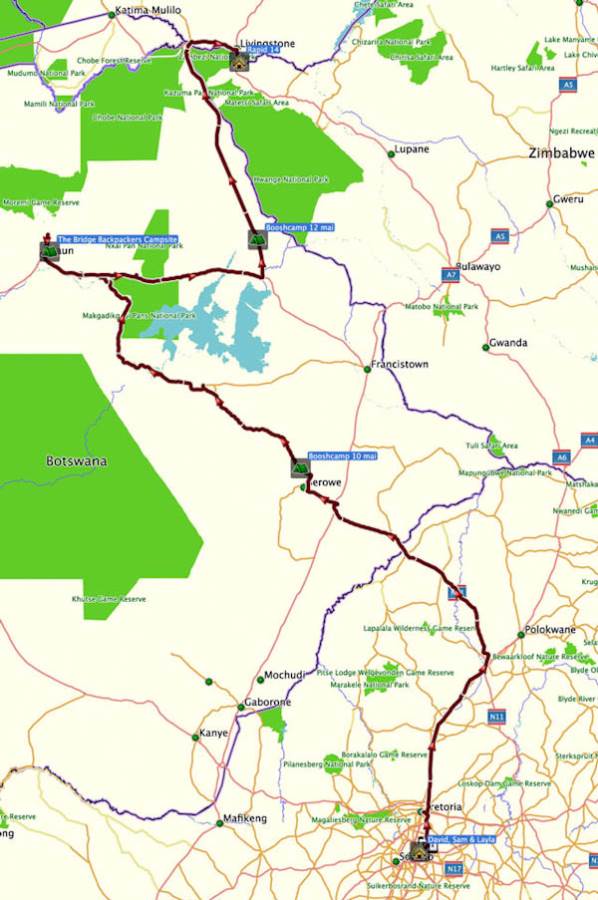
Crossing the border into the country where we would go back to our free camping routine was a bit of a hassle. No sign of the infamously laid-back Batswana. First, the VAT office in SAR had been shut down, so to claim the beefy 60 euros we were directed back to Pretoria. Then I had to drive back and forth between the two borders to be repeatedly refused exit or entry stamp in our new temp passports. Then we learnt that Botswana - for which we luckily didn't need a visa - demanded 240 Pula to allow us driving through (1 year road tax, driving permit and insurance). Tried to talk our way out of this, in vain. Only after we were way out of the customs premises I realized that the border bureau de change had paid our fees by mistake, giving us double the amount due for the dollars I wanted to exchange. Serendipity or poetic justice, anyway it was too late and we moved on. Gas is 8,9 Pula/l. BTW, even if in the local lingo (setswana) it means 'life giving rain' (key survival parameter for this land 80% covered by the Kalahari), the name of the Botswana currency will make any Romanian giggle.

Riding Botswana is like that say: flat, horizonless, boring, straight but decent tar cutting through sketchy villages lost in a largely dusty, deserted mass of land.



Except for curious meerkats standing by the road and for the surreal natural salt pans - world's largest - that stretch for 12,000 sq km. The life auspicious conditions will prevail on Earth for less than ten percent of the planet's overall lifespan. Our habitat is narrow, excluded by the deep ocean from two thirds, yet imagine that million years ago water was even more prevalent. These pans were once part of a massive inland lake that the San people (the original inhabitants of Botswana) have seen in their time. You could wander for weeks in the Makgadikgadi without encountering another human being, let alone the swarms of safari vehicles that make some of Africa's game parks seem like vehicular feeding frenzies. In rain season herds of wildebeests, springboks and one of Africa's last great zebra migrations turn the Makgadikgadi into a movable feast for predators such as lions, cheetahs, jackals and the rare brown hyena. This harsh wasteland becomes a lush green carpet of savanna grass. Shallow lakes also form then, providing nesting grounds for Africa's second-largest gathering of pink flamingoes. The pans remain - like many other natural wonders in Africa - largely off limits for motorcyclists. In the Mopipi pan, just a fraction of the Makgadikgadi system, we could hear ourselves self think.



Clouds of gray clay dust in this epic emptiness
Read more: Makgadikgadi Pans - Kalahari safari stirs the soul | Full Page

Since the 1966 independence Botswana has been enjoying a peaceful democracy, a happy accident in sub-saharan Africa. Barely 2 million people inhabit over 580,000 sq km, you bet it feels lonely. That also meant you could stop and camp at will and nobody would be appalled that we are shopping for groceries at the street side stalls and take water from pumps. This had been our last snack in South Africa:

We hit the 50K on the clock as well

After starting the day at 10 degrees Celsius… and barely able to venture outside our tent around 7.30 a.m. …

… we ended it one sweating copiously in the tourist hub and entry gate to the Okavango Delta, Maun. The town was too civilized for us to sleep like bums on its outskirts, so we would camp for the night at the Old Bridge Backpackers. The 'backpackers' attribute - we had learnt since Namibia - has nothing to do with actual backpacking, not in the southern-african subcontinent. It may well be the case for the entire East coast as well. It just means that camping in allowed on the premises and that sometimes accommodation in dorms is also offered, besides other sleeping arrangements. This place was laid back and friendly, but slightly run down and poorly maintained. Built a while back with less money than the very similar Ngepi in Caprivi, but just as expensive, clearly not targeting the budget travelers. As always when we slept in tourist hubs, we had a hard time falling asleep with all the partying and drinking going on at the campsite's bar. In the afternoon we had toured the airline offices at the airport to inquire about scenic flights over the delta, as the alternative to visit the Okavango by mokoro would take too long. Luckily by late evening we had met two travelers from Munich, who would made an old dream possible - so in the next morning our party of four (us two, plus Dominic and Stefan) was reporting for a ridiculously scrupulous security search in the diminutive Maun airport.

Airplanes being given a hand wash

Some fun data about our aircraft: also known as the ‘StationAir’, the sport-utility Cessna 206 is capable of taking up to five passengers. Fuel consumption 1l kerosene/ minute; range 5 hours. During our 45' flight we traveled for 228,82 km, covering 109,707 ha with a maximum speed of 300 km/h.



Andras, our US born pilot ( Major Blue Air | Excellence in Aviation) < link Major Blue Air | Excellence in Aviation > , heard that that was our maiden flight with a light aircraft and offered to entertain us with the 'adventurous' version. A frisky take off and a couple of funky maneuvers and we were hooked. The whole gang was trepidating with adrenaline. Eventually all the Gs made my head turn, so Andras suggested piloting the 4 seater would make me feel better!




Have I mentioned that all this awesomeness was happening a few hundred meters above the Okavango Delta, one of the Earth's most magical places?

The 16,000 sq km Okavango Delta is one of the world's few deltas that do not end into a river or the sea. First the Gumare rift changes the incline of the Okavango riverbed, thus the Delta is born. The river splits into three main channels, which later further split into dozens of others. The Thamalakane rift is where the inner delta ends, so the Okavango never reaches the ocean, partly evaporated, partly absorbed into the Kalahari. The Delta is a complex mosaic. Innumerable lagoons and water channels are cut perpendicularly by a radial network of trails (made by animals). Around them there are circular escarpments populated by water lilies and papyruses, the 'islands' of the Delta. Finally, there are the peripheral dry patches that never get fully flooded and that are mainly covered in grasses.



We had already had a glimpse of the delta's fringes back in February, when it was in full flood. Now we were Yann Artus Bertrand wannabes, attempting to gain perspective of the ensemble. During the 45 minutes we witnessed many intimate scenes of this unique biome: elephants and giraffes making their way across marshes, some lonely bull hanging out by a stream, hippos grazing or chilling while fully submerged in the many pools, zebras scattering, a rhino family, a huge crocodile basking in the sun, herds of antelopes and flocks of birds enjoying an unspoiled paradise.


The colors of water, sky and earth, the many shades and textures of grasses, the dry patches bearing the scabs of later summer's burnt trees - simply stunning.


The Delta was not at the peak of the flood, but the changing of the season was revealing new aspects of life in this vast, complex ecosystem. As we are short for words, please enjoy some humble photos of an only a corner of the amazing place we call home.




This small poem appropriately describes our experience
" High Flight" by John Gillespie Mage Jr.
Oh! I have slipped the surly bonds of Earth
And danced the skies on laughter-silvered winds;
Sunward I've climbed and joined the tumbling mirth
Of sun-split clouds - and done a hundred things
You have not dreamed of - wheeled and soared and swung
High in the sunlit silence. Hovering there
I've chased the shouting wing along, and flung
My eager craft through footless halls of air.
Up, up the long, delirious, burning blue,
I've topped the wind-swept heights with easy grace
Where never lark, or even eagle flew -
And while with silent, lifting mind I've trod
The high untrespassed sanctity of space
Put out my hand and touched the face of God.
After such an exhilarating morning, we needed a moment to clear our heads. Our German buddies bought us a couple of iced lattes in a swanky cafe across the airport, a nice place to chat a bit with our cool pilot. As it turned out, the job is good for hours, but it doesn't pay well enough for his ambitions that should see him landing a commercial airline job somewhere in Europe. What followed was a quite appropriate monotonous drive across Botswana. We were all adrenalined out, and anyway motorbikes are probated to enter inside the arguably wonderlands of Nxai or Makgadikgadi Pans or on the Kubu island. This in turn offered the space to digest the memories of the Delta as seen from the sky.


We knew the road to Zambia would cross Chobe National park and incidentally the migration corridor of many wild animals. So we pitched camp within reasonable distance from the known cut-off, and warn the critters of our presence with a safety fire. One of those perfect spots it was.


Charged by another mesmerizing sunrise, we rolled - impatient to see lots of wildlife - into a large operation to enlarge the road, which has disrupted the migration path of the animals crossing from Zim to Chobe. But we did spot some big game though, many many miles further north, besides duikas, warthogs, elands and many species of birds.


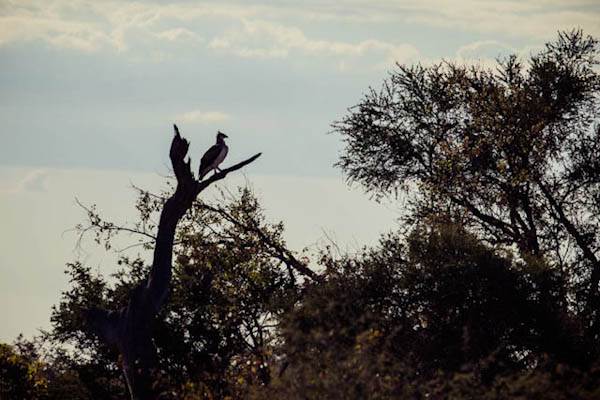

It's mind boggling how these giants have adapted to man's presence and ever increasing appetite for territories.



At the border we met with a large group of super equipped South African holiday makers.

Together we hoped on the 15 minutes ride across the Zambezi by a 30 Pula ferry.



A group of mokoros zoomed before our eyes across the channel, the fishermen looking as smooth and athletic as their Durban kaiak rowers counterparts. Just that these people are not exactly doing it for fun.

Back in Zambia we were jolted back to the realization that we were back in the Black Africa as well: chaotic border control and hoards of middle men trying to extort newcomers. As the police had the South-Africans by the balls, we managed to slide under their radar and make our way out of the mess without paying a dime. But faith was awaiting in Livingstone: while negotiating the exchange rate of our last 160 Pula for the local Kwachas, an opportunistic money changer seized the moment and simply grabbed my moneys. Before I could step off the bike or alert anyone he was gone. The Spar supermarket that had been under construction in February was now open for business, so we wiped off the bitterness with chicken and rice, then loaded with fresh veggies from the market we were off to Rapid 14.
|

4 Jun 2012
|
|
Registered Users
Veteran HUBBer
|
|
Join Date: Mar 2010
Location: Bucharest, Romania
Posts: 117
|
|
|
Dust, Sweat And Prayers in Zambia
\ 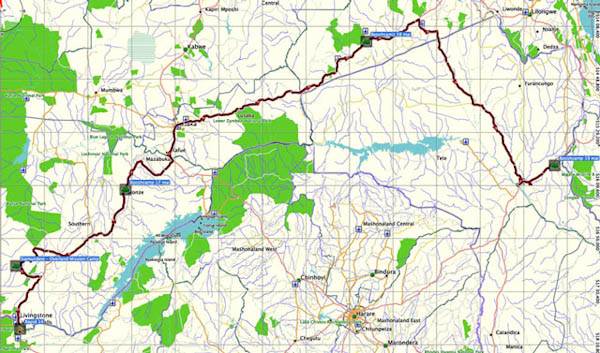
In Livingstone the turquoise cabs were desperate for customers.

Riding the steep track to Nsogwe, we could smell the falls, see the wave of mist now a shadow of its February might. We had butterflies in our stomachs. It felt like coming home: returning somewhere for the first time in over 10 months. There we knew people's names and every single corner. There we had a past, and we had come back to recover that link. Surprisingly, wifi is hard to find in Joburg and even more a precious commodity in Botswana, so we hadn't warned of our imminent arrival. But we found everybody in good health and received some very happy news for the end of the year. Laura's parents were ending their visit with a vow to return in a couple of years. Some things were different though:

The colors had faded away into shades of rust and gold, after simmering all summer. The camp looked older, as we were as well, wiser, as we hoped to had grown. More drama was filling up the gorge, the Zambezi wider and now flooding the rocky beaches under its swarming rapids. But the roar of the river and those awesome sunsets that only happen at Rapid 14 were just as we remembered them. Unfortunately this time we would stay for three nights only, to spend time with the gang, clean and organize our stuff.





The base was now fully operational: teams being shipped into the field, dozen of staff working around a very busy schedule. That would go on for months. The night of our arrival also the founder of Overland arrived. Phil told us that after serving in the South African military, he had traveled independently for six years throughout more than 40 countries, then worked as international instructor for Camel Trophy. In 1999 he founded Overland with his wife Sharon, committing to bring the Gospel, humanitarian care and economic opportunities to communities that remain isolated by geography. The couple had been rated one of the top 30 emerging voices in the USA for their work in developing nations.
A few years ago, Pete had taken part in an Overland expedition in the Amazon. Then we went briefly to Zambia. Next year he stayed at the base for 3 months, next year for 7. In 2012 he decided to live permanently at rapid 14. 'If you need something done, I am happy to help', he offered. We could squeeze some bike work, I thought. Together we fabricated the bash plate bracket, a 2.0 version, sturdier than the original already broken twice (Lumbumbashi & Namibia). We also welded some holes in the exhaust to temper a tad its scream.



Way too soon, it was time to leave. Laura could not have put it any better: saying good bye twice was not going to cut it. Next time we needed to make a plan and stay. Verba volant, scripta manent: there will be this next time. As we were preparing to go, Pete was summoned in the field. It was one of the expeditions' trucks. Stuck somewhere deep in the bush in the Nyhawa chiefdom, the field team having to push-start it for days. 'It's a one day job', Pete said: 'go in, replace the part, go out'. 'You should come along', he suggested, 'spend the night in the village with the expedition, then continue to Lusaka the next day'. Brilliant, let's do it.


90 kays north of Livingstone, in Zima, we went off the tarred road down to Nyhawa central. Lucky that the pastor's wife correctly suspected that we should track down our people in the Siamundele village.


We got to see some field action. The young US missionaries have been living in the chiefdom for a week: walking for hours to visit the huts, helping the villagers with house chores, offering counseling and spiritual guidance, organizing school activities and even a football match.


As we have seen across Africa, the church offers a common ground for artistic expression, personal and spiritual engagement and much more. African would always incorporate dancing, choral music and even theatrical performances (as we had seen in DRC in Mission Kalonda) in the worship. And of course there are a lot of animist beliefs still shaping every day life. In this particular cluster of villages, like in many other in the unseen and little known Zambia, there is a quite influential 'witch doctor'. People would employ this dude for protection, only to become dependent on his expensive manipulations.




Watching the kids taking part in the activities made us think of the DRC. Zambia looked so different now than back in February. On the main road and in the towns the globalization was striking, but here, deep in the rural Zambia, not so much. Sure, Zambians are tamer and shyer than the Congolese, but they share a helluva lot of common features. It was exciting to experience simple life, even if mass consumerism is slowly taking over the country. But people suffer from lack of proper education: severe migraines caused by dehydration, diet poor in nutrients, sketchy agriculture, the same story. Overland projects focus on education and teaching: how to feed better (introduce cheap proteins like beans in children's diet), how to grow food better.



Tonga, the dominant ethnic group in south Zambia, have an end of day ritual: dancing by the fire with the 'shetenge' (African skirt). We had seen something similar in a Gabonese orphanage.

After a full day of riding, dancing and story telling by the camp fire and after having our first ever SMORE ( an American 'give me some more' camping desert: roasted marshmallow sandwiched with a piece of chocolate between two rye cookies) we were knackered. Since leaving Cape Town weather has been warming up, but days have also become shorter and shorter. It was now getting dark around 6.30 p.m. and the mornings were at times very chilly indeed. This time we woke up more frisky than usual, as Pete had come up with a new plan.

10 years ago Jako left his home in South Africa behind, and Amber left the States, for a lost corner of Zambia. 6 years ago these pals of Pete founded an orphanage and a preschool, out of the government radar. To learn more about Jako's project visit Mission Of Love Community Orphanage Zambia - Home.
The plan was to ride across the bushveld to visit Jako, Amber and their sons, Jacob and Jeremiah. To reach Jako all we had was a hand drawn sketch by the Nihawa pastor and our navigation skills. We knew the locals would guide us thru. It was a 70 kays task. A maze of trails. In Southern Africa we learnt that this kind of terrain is called cotton soil. A deep layer of a powdery unstable mix of dirt and sand, tricky in dry season (and we were lucky to be in that benevolent time of the year), but deadly in the wet. When it is drenched, its sticky, swampy, but solidifies like concrete between downpours. Ironically, cotton plantations doubled the cotton road.


That must be how the Kinshasa - Lubumbashi road would unfold in the dry. I'd do it again, 2up even. Crossing in the rainy season was slightly insane. In Zambia we found that confusing pattern of deviations and footpaths, but no anonymous heroes to work the road.
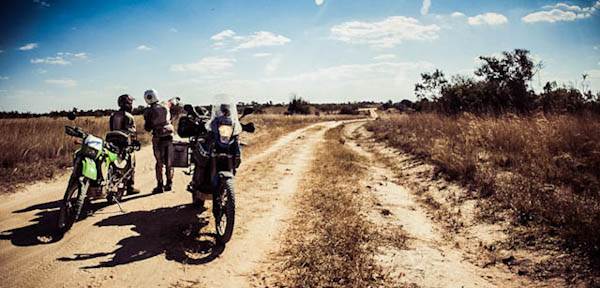

The most crucial aspects separating Zambia from the DRC are that the tonga villagers will eventual hit tar, thus a vital network of motorized food and medical supplies; many Zambian villages have beet fitted with water pumps, rendering people less vulnerable to drought. The rainy season is also more forgiving in this part of Africa, the government less corrupt, allowing some cash to flow into the infrastructure and some humanitarian projects to develop. End of rant, back to the road. Pete has some problems with the tyre pressure.

At Jacko's we had had some time to see the project and had lunch. 40 km of 'cotton' later, in Kalomo, we parted ways with Pete. We scrambled for a bush camp in the tall grasses, another reminder of the DRC. In the morning the tent was drenched in dew.

Before noon we were out of Lusaka: Bomoko oats and roasted chicken from Pick&pay - check, Motul oil from Ali Boats Yamaha - check. East Zambia had a more tropical feel and as the nights continued to become longer, they also became warmer. Crossing the rolling valley of Luangwa we could imagine that the northern and southern national parks must be beautiful. Here the parks were unfenced, bordered by GMAs (Game Management Areas), populated by both game and humans. But we were determined not to cross borders on sundays, so we a bit in a hurry to be in Mozambique the next day.



Sunset had been at 5.10 p.m., sunrise was scheduled for 5.56 a.m. At 5.15 a.m. the horizon was already blushing. Tent wet again, little puddles have formed where the poles reach the ground.


We had devised a system to warn critters we were there: poke the grass with a long stick, as there are snakes around here and last night we had some rodent foraging about. We had also capped the exhausts with the  bottles we had for dinner.

|

17 Jun 2012
|
|
Registered Users
Veteran HUBBer
|
|
Join Date: Mar 2010
Location: Bucharest, Romania
Posts: 117
|
|
|
Tudo Bem?
Mozambique 19-23/05/2012

With the exception of the Tete and Niassa provinces - where we would enter it - Mozambique lies within 300 km of its 2500 km coastline. Two thirds the size of South Africa, it lured us not only with its legendary tiger prawns that were supposed to be jumping straight into the pan along the beaches, but also with the unique blend of Latino and African cultures. Besides vernacular Bantu, some Arabic, Makonde and Swahili in the north, the official language of the world's best sailors' colony is Portuguese. Romanian is closest to Portuguese. Hence, we were very keen to practice.

We had our first attempt at Portuguese right at the border. Our successful conversation - as sketchy as it was - beefed up our enthusiasm for this 17th country we were visiting in Africa. In less than 30 minutes, chit chat with the lovely chaps on both sides included, we were stamped in Mozambique, no muss, no fuss. We had payed 27 Meticais - not even 1 Euro! - for the 14 days Temp Import Permit. We asked which side of the road were we supposed to drive, and off we went. Brilliant. We already loved the place.

Let's talk about how much fun is riding on a dirt road suffocated in a cloud of dust. How about a lot? Now, don't get us wrong. We play the game, too. Saving time and rubber, not breaking every bone in our bodies and arriving at embassies in decent shape are all good. The unpredictability of the African infrastructure though is that temporary escape from the Tar Prison we live in. We might look like a mess when we apply for our next visa and inspire a few odd stares with our frizzy hair and shredded soiled gear, but, yeah, baby, nothing beats the open - literally road. We knew well of the over-developed southern half of Mozambique, so we had planned a less traveled route: across the Zambezia province, thru Tete. The idea being to ride off road along the mighty Zambezi, then cross it - if the ferry was operational - somewhere before Caia, after which we would finally get a taste of the Mozambican tarmac. Our plan worked pretty well.
Day two, 2.00 p.m.

Day four, 12.45

Rewinding to day one, we spent the better part of the day riding through a very poor, but quite picturesque rural region, dirt huts, most people on foot. Maybe once every two hours a shiny 4x4 would UFO through. In Tete we got some bad news: petrol was the most expensive so far in Africa, about 15 Rand/l (6,5 Ron) and the roads we wanted to take after the Moatize were now private because of coal mining. Our target for the next day, a bumpy dirt track, was behind the baobab forest.
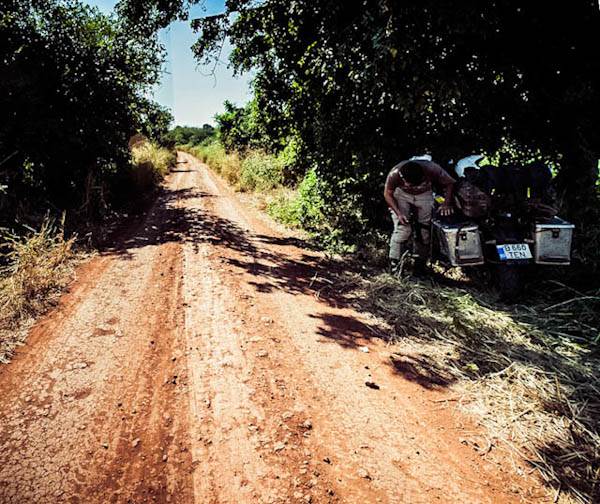

Dawn at 5.22 p.m., we had a bush camp with a view of Malawi. We fetched supper - potato samosas(1 Metical a pop), avocado, tomatoes, bananas and the famous Mozambican bread rolls.


We almost went full retard on day two. The sunrise kick started us, so by 7.30 a.m. we had an awesome off road swagger. The road has everything you could ask for. Demanding, if not a bit technical, alternating gravel, dirt, deep sand, rocky plateaus, even dry river beds and huge rocks. This must be a bitch in the wet.


While trying to find the best passage thru this temperamental road profile, we almost collided with a scooter taxi coming from the opposite direction. I had to stop in the high dirt bank. Right mirror broken (again!), some scratches on the fairings, new dents in the pannier, and 15 km later I noticed the right light also missing. So for the next 60 kays we cooled it down to about 40 kays per hour. Sunday, we noticed, was a regular weekday around there: women do laundry, harvest crops, fetch water from pumps or boreholes, carry fire wood, sieve maizena; men go about their business, kids play in the dirt or help with household chores. Our lunch time snack of canned tuna, avocado and bread stirred some interest from the villagers, but nobody bothered us. These people are different. Chilled, shy even.

At the odd junction with the rail road I got a 'boa tarde' from a cyclist. I was glad I knew how to greet him back.

We had been out of water for hours, when finally spotted a pump. Thanks EU!

After 279 km of powder and sun we were spent. We had hit the Dona Ana Bridge, at its time the longest railway bridge in Africa, spanning for 3,67 km the Lower Zambezi. The bridge cost more than £1,400,000 in 1935 and is even today an example of engineering achievement.
link Dona Ana Bridge - Wikipedia, the free encyclopedia
sau OVER RIVER AND LAKE
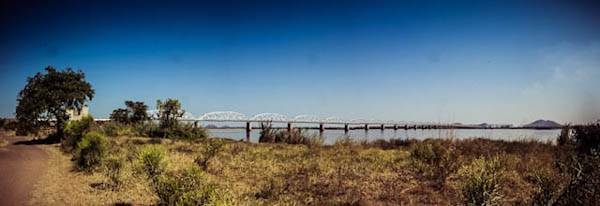
As we were waiting for the train to pass, we spotted pedestrians and cyclists coming from the bridge. Could we cross it as well, instead of searching for a ferry ahead that might be working on not, especially on a Sunday? That required some investigation.

The villagers helped us navigate the maze of paths leading to the bridge, where we discovered we needed to climb a 45 degrees flight of stairs in order to access the pedestrian way. With the panniers off and the strength of me plus other 4 men combined, the bike was up. I generally don't give money to people, but I figured it was the decent thing to buy them some  .



Seen from up, white and purple water lilies populated islets on the Zambezi, making the river look like an immense delta. You would never suspect somewhere on this calm flow of water the untamed Victoria. Midway across, there was a couple of concrete slabs missing. The crowd cheered when we lifted the bike across the gap. That's what the end of the bridge looked like on the other side, next to a small market:

You're on African off road if it's covered in man. Most are walking, some cycling, some even napping, completely zoned out on a bag of maize. The African road is a place of awe and companionship. We often get to see man's most ingenious attempt to carry a shitload of stuff, be greeted by passer-byes and get waived-through by policemen with a boner at the sight of our bike.
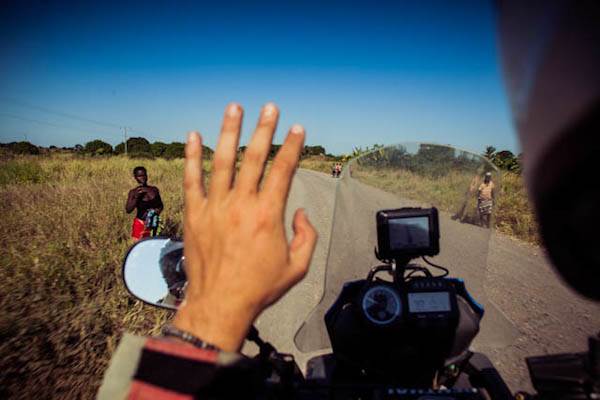
In Caia we crossed Zambezi for a second time.

We found gas and in the next village tomatoes, avocado, bananas and a crumbly cookie of crystallized sugar, honey and ground nuts. People kept surprising us with their laid back attitude, minus the occasional snap. We had a feeling they could become a highlight for our African travels.


By now a habit of serious landscaping for every bush camp had been established. To pitch a tent in the 1,5 m tall grass meant we had to work for 20 minutes, using our boots for shovels and our hands to clean up the spot, while various species of bugs would feast on our sweaty bodies. That's what the campsite looked like after packing up:

Morning fog

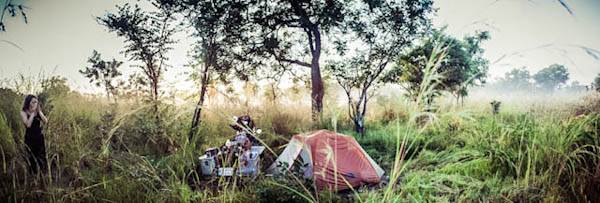
Midmorning we had reached sleepy Quelimane, now only a shadow of its former glory, when it was an important port for the gold, ivory and slaves trade. David Livingstone was appointed the British Honorary Consul to Quelimane in 1858, and later started his crucial exploration from the Zambezi from here. Splendid but crumbling down colonial ghosts lie next to moldy Corbusier-era architecture. Housing complex, residential villas, public buildings, this place would deserve a future.





The internet was painfully slow in the only shop we could find, but while searching for a cyber cafe, we stumbled upon a Mozambican tradition: the pastelaria. If we had arrived in this country for the rumored seafood, we were to stay for the bakery. A moist desiccated coconut cookie and an aerated sponge cake with a hint of dulche de leche introduced us to local pastelarias.


Coconut-palm plantations stretch as far as the eye can see, but go largely unharvested along the 33-kilometre run down to the Zalala beach.


The fishing village was nothing like the palm fringed beaches we have heard about; we were the only non-fishermen, so finding a place to camp generated some commotion in the village. We settled on the lawn of some deserted guest house, whose owner proved to be the chief of police. The office was actually right across the sandy road, so at least we were safe. Within 10 minutes we were off to the beech to find fish and fishermen. Less than 24 hours later we were packing up after one of our most efficient pit stops. We had managed to: buy and grill seafood, make the unpardonable mistake to buy fish that was a bit off (the guardian took it), do all our laundry and shower (with a bucket and cold rainwater of course). We were back roughening it up, baby. Ana had given me a fresh haircut using the frontal Petzl as only light (which in the morning we unanimously decided it's a good tradition to start).




The venue for our next breakfast, back in Quelimane, turned out to be the best pastelaria in town (owned by friendly Arabs). Very good cup of coffee, but the pastries! The caramel danish, the mille feuilles with a fragrant vanilla filling, the house special almond muffin. As we sank our teeth into the crispy outside layer of the last pastry on the plate and felt the moist coconut concoction inside, oozing with flavor, we were in love. We knew the only way to put an end to that delicious delirium was to pay our bill and just go. Running away from guilty pleasures that was.

The Mozambican bakers also produce some of the best bread rolls and an astonishing variety of doughnuts (eaten for breakfast in a maizena congee), cookies and biscotti, prices ranging from 2 to 5 Meticais. Savoury street food is limited to samosas and hard boiled eggs, the rest are a proof of the Mozambican sweet tooth.


The uneventful tar to Nampula soon collapsed in the purest African spirit, swallowed by gravel and dirt, decorated with all the potholes in the whole of South Africa and Namibia combined.




We had no choice that night but to camp in a field of cassava. Chance to test the people of Mozambique for friendly attitude towards squatters. A villager spotted us after a few minutes, and later came back accompanied by 3 other men. They waved shyly and asked permission to approach, then we had a basic chat, just said we are sleeping there for one night, and that was it. Nobody else came, not that night, not in the morning. If these are not the most peaceful Africans we don't know who is.

Nampula may be Mozambique's third largest city, but it felt less alive than Quelimane. Slightly run down, a handful of notable buildings, and this interesting mural. If you will be going to Maputo you'll spot plenty of these. Mural art emerged in Mozambique in the 1970s in the context of the revolutionary struggle and then the transition to a postcolonial society. The renewal of the physical urban environment and, more broadly, of the social, economic and political fabric of the entire country, spawned a national identity, even arguably a national style. The artists used Makonde mapico (mapiko) masquerade or machinamu ancestor figures, slogans and symbols of European domination to investigate the mystical power attributed to colonists and to interrogate the political future of the nation.




We wanted to try the local pastelarias, but what a disappointment. The only one where we could sit down and eat was this communist establishment where the pastries (even pastilla de nata) were boring and the clientele looked like the local mother ****ers' convention. Totally reminding us of our parents stories from the communist Romania, when the restaurants were empty, menus were pretentious and ample and nobody could afford them. We have see plenty of similar places across this part of Mozambique: ancient restaurants and tourist spots where a chicken dish would fare 400 Meticais, in a country where a big bread roll is 5 and a regular one is 2. So 200 of these babies would just buy you a questionable plate of stew and corn meal. Pretty damn sad.


The ground nut and honey cookies were smashing.


Fresh produce is local, just like in Morocco: pineapple, papaya, tomatoes, salad, cucumber, avocado and pumpkin can be found only in certain areas; oranges are available countrywide, as are bananas. Vendors tend to quote fair prices (except some dude who wanted to seel for LOL price of 700 a 50 Meticais machete). Moving further north we finally hit cashew nut country, wich you buy by the 150 Meticais basinet.

Another chameleon moved from the busy road to the safety of the bush. We love these guys!


|

19 Jun 2012
|
|
Registered Users
Veteran HUBBer
|
|
Join Date: Mar 2010
Location: Bucharest, Romania
Posts: 117
|
|
|
Ilha de Moçambique
Mozambique 23-24/05/2012
As the baobabs made way for the palm again, we reached the mesmerizing Ilha de Moçambique (pro*nounced ilea de musa’biki), the country's original island capital and World Heritage Site since 1991. This is the unpolished gem of the African east coast: grand colonial architecture stands monument to a past, from the entrance to the old dockyard to the urban residencies in the cidade de pedra (Stone Town) and the once impenetrable Fort of Sāo Sebastiāo. The name Mozambique is derived from Muss Mbiki, the Sultan of the Ilha when the Portuguese arrived there in the 15th century. The Ilha is linked to the mainland by a 3,5 km causeway. The southern end of the island is the poorer neighborhood called cidade de makuti (palm frond town). The huts are where the locals actually live and contrast sharply with the faded architecture of the rest of the former hub to the entire sea route between Portugal and the far East. The Makuti slum was built in the quarries that had provided the stone for the 400 colonial buildings; a parede social (wall) separates the two residential areas.



On the northern end of the Ilha, narrow streets wind between the double-storeyed coral stone buildings of the old Stone Town. This was the aristocrats' territory, an eclectic mix of Portuguese and East African architecture. Few houses have been restored, due to conflicting ownership and governmental stammer. Many are only shells, held together by roots and vines of wild fid trees. Some streetscape:


The paint peels off facades in layers of it-will-never-the-same-again
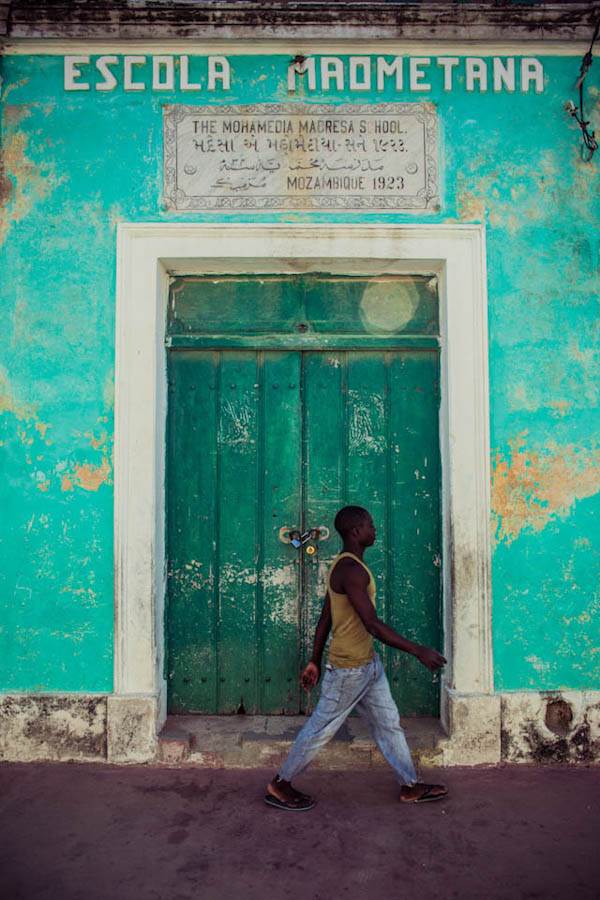

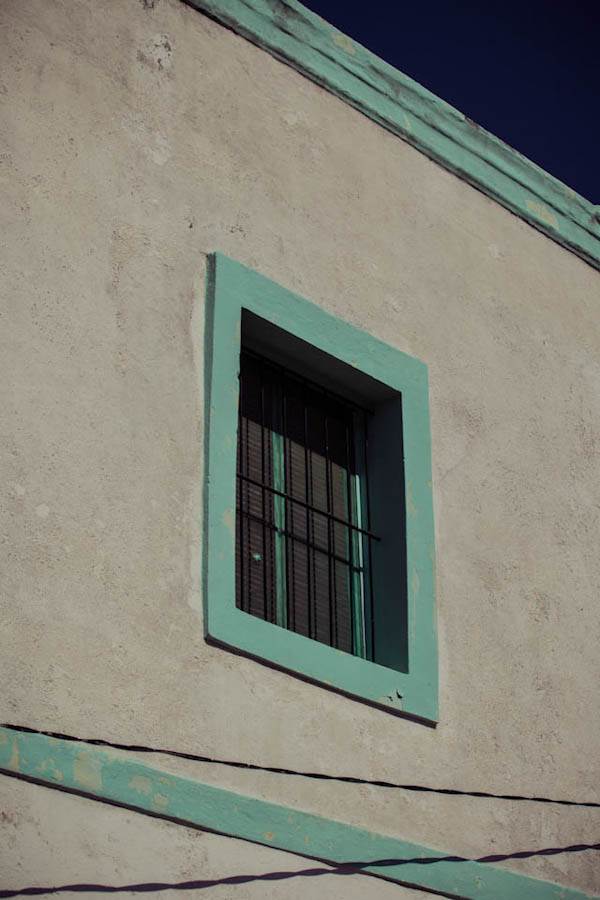
But life goes on



When Vasco da Gama landed here in 1498, Ilha de Moçambique was already a well established trading port, linked to Zanzibar, Madagascar, Oman and Persia. It is the island that gave the nation of Mozambique its name, not the other way around. By the 16th century it had become a permanent Portuguese station for their ships and crews sailing to the eastern bases in Macau and Goa. Various early 20th century events (discovery of gold in the Transvaal, the Suez Canal inauguration, the rise of the port of Maputo) led to the decay of the island's economy. Population shrunk, buildings collapsed and sadly many irreplaceable carvings, shutters and furniture had been used as firewood by civil war refugees.
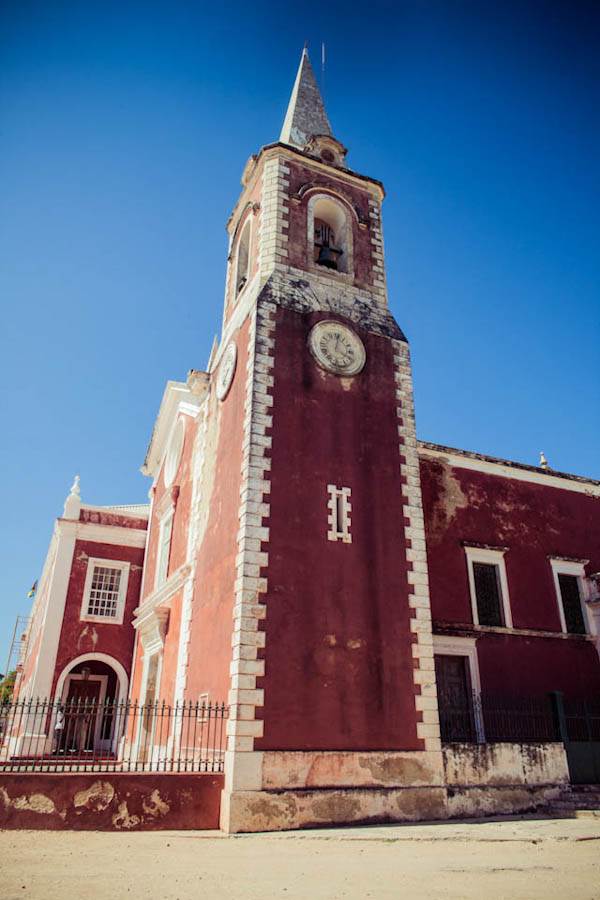

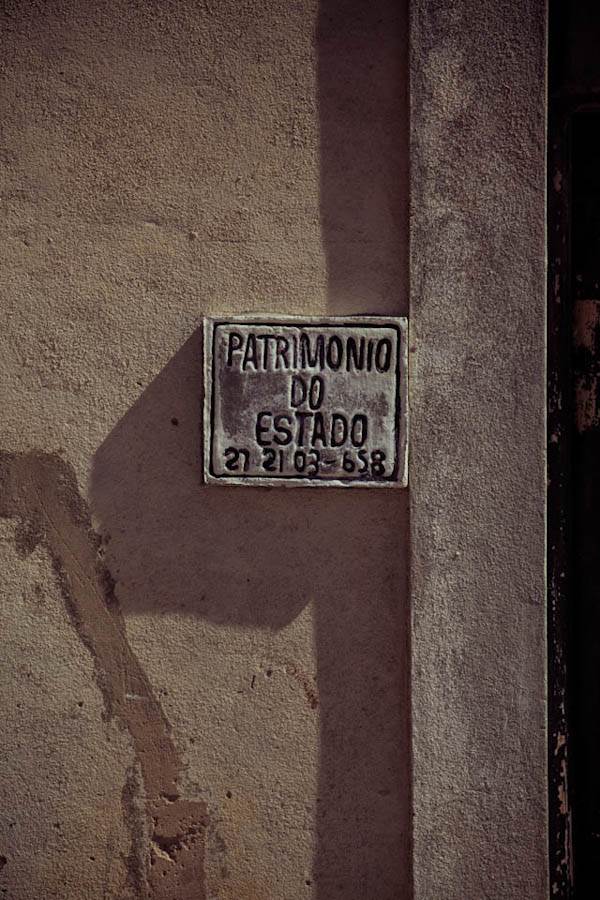

School


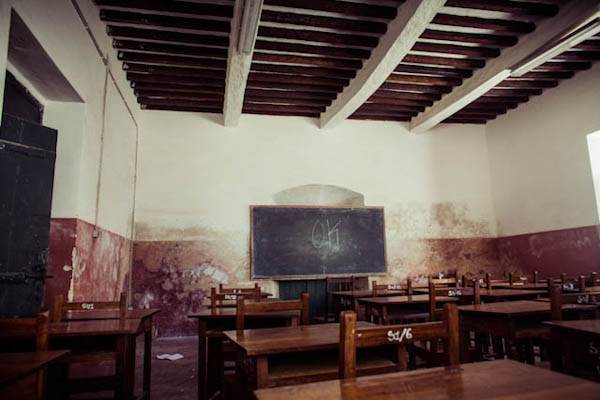
In the small fishing harbor of Santo Antonio families gathered on the praia (beach) to sort the day's catch and chillax. Check out the traditional boats, called dhow.



Not even these Muslim fishermen were daring enough to demand being photographed, but once one would be so cheeky to ask us, a photo frenzy would ensue.



Look at the fabulous catch! Mollusks, sea urchin, octopus and all sort of exotic species, hunted with spears and small fishing nets. Must be sold to fancy restaurants?

Chatty locals kids have captivating bright eyes
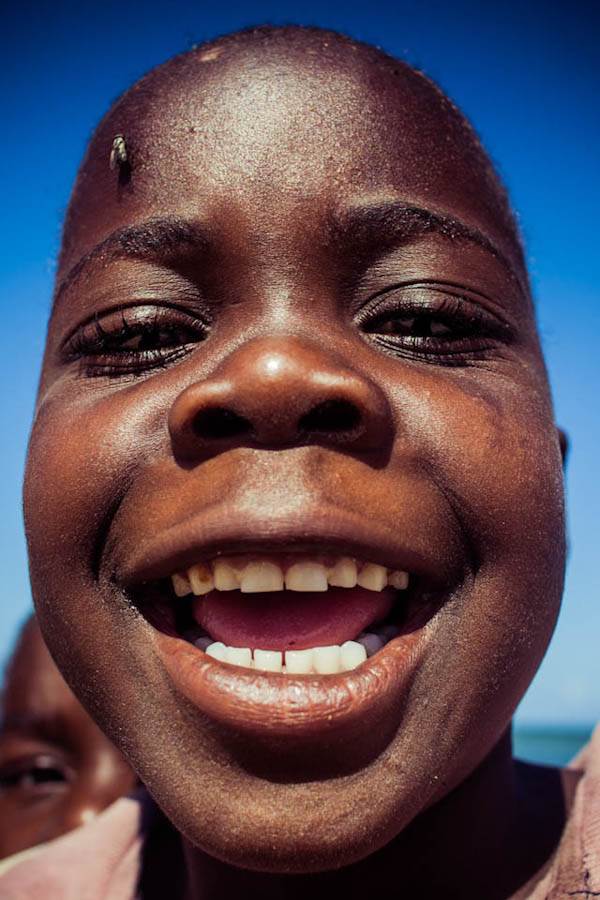



Mina and some play buddies



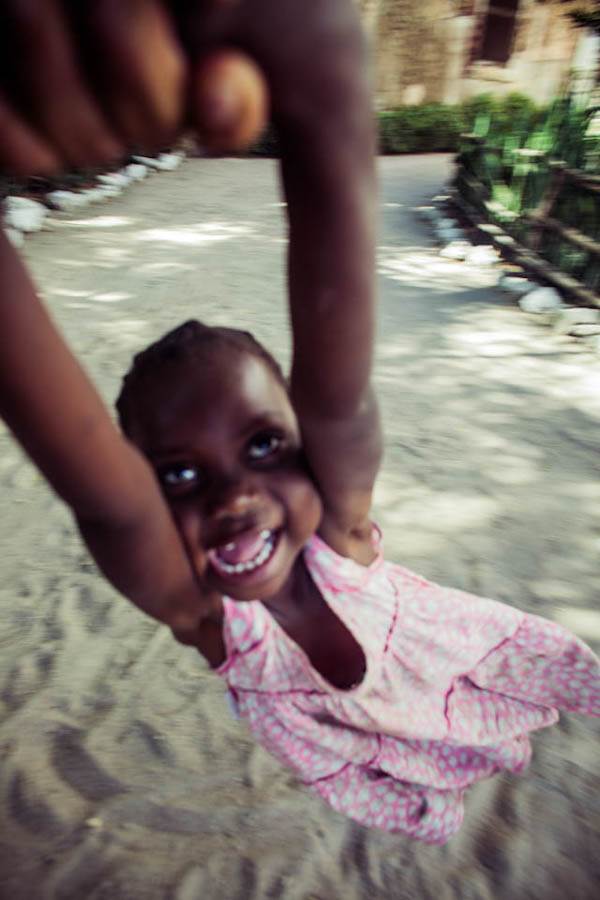
Me and my pal, Saidi


We wanted to sleep on the island, and we were too shy to squat on the beach. But the dorms were too expensive, so we were looking at another night in the cassava bush. Only in the morning we would realize how risky had been our pick. Too tired and unable to navigate in the dark, we had pitched our camp right between a village road and a neighborhood path.

A little after 5 a.m. we had already made acquaintance with Amina, Anija, Ajira and Antonio. Sweet people (even the Portuguese had called this place Terra da Boa Gente - 'Country of the Good People'). They were genuinely happy to see us, and we printed some photos for them. Ajira was quite elegant with her basket. Amina was the only one who mentioned briefly a money gift and her nephew inquired if we could employ him. That is another reminder of DRC: frequently foreigners who build the roads squat in tents and say they are 'in transit', so it makes sense that when there's word of white people sleeping nearby, villagers would gather and look for temporary jobs. That became a hassle in DRC, when it proves eagerness to work.

|

20 Jun 2012
|
|
Registered Users
Veteran HUBBer
|
|
Join Date: Mar 2010
Location: Bucharest, Romania
Posts: 117
|
|
|
Mozambeech, Tsetse Flies And A Scorpion In My Pants
Mozambique 24-31/05/2012

African dust for breakfast? Heck to the yes! Test our Anakee tyre on some dirt? We got what we were in for. The rugged, kind of lonely road boasted fantastic scenery tho': rocky outcrops, koppies and pinnacles rising up sheer from the flat countryside. We had arrived at the southern end of the longest rift system on earth, that stretches for 6400 km, up to the Horn of Africa and Jordan.




Nice bridges even on these dirt roads. Old folks sitting on their palm frond benches flashed their gums as we rode by.

I was rocking the dirt, rocking the gravel, rocking the deep sand and the boulders. It seemed like nothing could stop me, I was Bikatron, carrying our sorry asses from village to village, stopping only to replenish our water supply in the cheer of the kids. The gear lever was my Achilles tendon, hanging loose for some time now, like an overworn pair of undies.


It happened all of a sudden. The gear lever was kaputt. Wouldn't downshift. I rode a good 30 km stretch in the 4th, but all this involuntary bunny hopping on that trenchy terrain couldn't possibly have any favorable outcome. We stopped to do something about it in the middle of a village, knowing this would be the friendliest crowd. It's hard to stomach the fact that more than one in ten people we see in these photos will be dead in five years because of AIDS. Most children get infected while being nursed by HIV positive mothers, receiving at the same time the precious gift of life, and a death sentence.



The bush was steaming. All that could be done was adjust the lever to a somewhat grippier position, which under those riding conditions would mean squat. So until we reached tarmac I kept stopping to hand-gear, then kick it off again. And again.

When camping, the first couple of days without showering have an i-am-one-with-nature feel to them. After the trip in the HippyLand is over, it's just an itch and bad smell affair all over. In Pemba, we desperately needed a place to shower and rest for a bit. And where were those famous Mozambique beaches anyway? The industrial town lies in the deepest natural bay in Africa and has been recently blessed/ cursed with the discovery of the world's second largest (if not the number one) gas pocket. There's offshore drilling and corporate brunching, prices are high and food is scarce.

After checking out the other popular backpackers, we settled for Pemba Bush Camp.

Rudi was born in East London, but he spent his teenage years in Mozambique, where his father had been appointed General Consul. Found a nice piece of land populated by mangroves and baobabs, in a quiet bay in Pemba and started building. A few years ago, he opened a lodge on that piece of land. Lots of freebies to keep one busy there: welcome drink (homemade baobab juice); braai, chairs & lockable chest @ campsite; shared kitchen; wifi (when generator is on, 12 a.m. - 12 p.m.), kayak, archery, nature walks with Rudi's son, and mud bath. If you can afford it, Rudi cooks great dinners and buffet brunch on sundays. We couldn't, but, for some reason, Rudi liked us, so he invited us for dinner anyway.




The down-to-earth, chilled staff were our kind of people, so we decided to linger for a few days.



We started our fish hunt in the village of Paquetequete. Every species was there, rotting on ice in wooden trunks. Nothing was fresh.

It was 7.00 in the morning and the sun was already high in the sky. We took the kayak and rowed to a bay where fishermen were pulling their nets. Small-scale artizan fishing communities in Mozambique struggle to eke out a living in remote areas with depleting resources. The fishermen called us to join the group effort. It took over 2 hours and 13 people to pull that out, while two ladies were sieving the shallows for any escapee. After laying the nets, the fishermen divide in two groups that start pulling from the sides. Each person wraps around the hips a cord, that is later attached to a knot on the net cord. Unfortunately these waters have been overfished, and our work in the sun barely yielded a couple of fish. It’s a hard, mostly subsistence existence for these people.

After one day we had our lebanese vendor where we would buy eggs and bread, and even managed to find stalls with fresh fish on Wimbe beach. Then we spotted a boy with a basket covered in shrubs (actually selling prawns). We could finally have our feast.



Manica and 2M are competing for the national  title. I am not the man to discriminate.

Ana didn't drink Manica, but got hooked on masanica, a wild berry she would pick from around the campsite. It tastes of wild apple, each unique flavor depending on the color, and the tree the berry fell from. Cause you don't pick these babies from the tree, but off the floor.

We walked among the baobabs and mangroves with Kai-Uwe and Thomas, a backpacking DJ from Vienna


View from inside this 1800 years old giant

Tsetse flies fed on Ana, who took one for the team, and saved my groin, as the scorpio hidden in my riding pants stung her, and not me. Note to self, never leave any gear outdoor again.

To make Ana feel better, Kai-Uwe took us to a sort of natural spa. The main ingredient of the mud is crab poop, rich in sulphur and minerals that exfoliate and soothe skin and hair. It was greet fun.




The corridor between Mozambique and Tanzania is now open, and the expensive ferry can be avoided passing the newly inaugurated Unity Bridge. Immigration & Customs are in Negomano. The morning we were set to take this route, Pemba was hit with the last rain until December. We left at noon, only to find rain on the way, so rode back another 40 km to camp in the dry. Antonio, a farmer who had moved from Nampula to raise cattle, arrived a couple of minutes later to let us know we were about to squat on his land. Wouldn't we prefer to come to his house, instead? (he offered) We would hang out and get to meet his old lady, he said. Now, who can argue with that?

Our home was pitched in 10 minutes. We learnt that it had taken Antonio 2 days to build theirs.

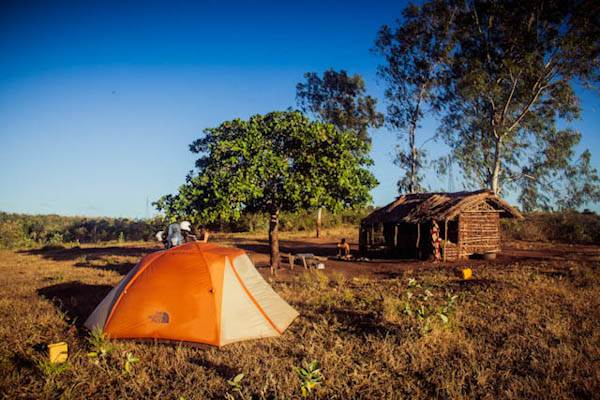

The hut has two rooms: a kitchen and a bedroom, but Antonio wanted to keep us company, so he pulled out the bed for a night under the stars. Ana laid eggs, tea and biscuits. Francisca cooked rice and fava beans. Faseli, their shepherd, went to the village, to get their best friends, señor Pumbolo and wife, to join us. What a great night!

In the morning we had promised to swing by señor Pumbolo's house to say bye. Our visit drew a seizable crowd, instantly catapulting Pumbolo as favourite for the next village chief elections.
We spent the rest of the day riding across the stunning Forestry & Hunting Reserve that lines the Niassa National Park. The dirt road has very thick powder dust and heavy trucks had left behind many potholes after the rainy season. It was damp, and wild. We munched on whatever we had find in the last village before the reserve.


We spotted baboons, macaques, birds, blue-assed duiker. It was time to get some rest. There were plenty dead trees lying around. Our machete had cracked in two in Namibia months back. But MacGyver was in the house: I tossed the wood and set it on fire to give a neighborly hint to the lions. Could that be the best bushcamp ever? In our tent we closed our eyes, and enjoyed the kaleidoscopes behind the eyelids.

|

25 Jun 2012
|
|
Registered Users
Veteran HUBBer
|
|
Join Date: Mar 2010
Location: Bucharest, Romania
Posts: 117
|
|
|
Eat. Pay. Love
Tanzania 31/05 - 03/06/2012

Save your money. Tanzania wants your blood, sweat and tears. It wants you cash-drained and on the next plane to wherever you came from. This vast country boasts stellar safari destinations, a tropical archipelago with some of the best diving on the planet and the highest peak in Africa. We craned our imagination at Ngorongoro, explored Serengeti behind eyelids wide shut and climbed Kilimajaro in our dreams. But to enjoy all that, and afford to travel around the world, you'd better own the Internet. Now, we decided we would not be bitter about that, 'cause you know, best things in life are free. The plan was to ride some dirt, see some lake, sail some sea and have a ball while not thinking about the fact that we had arrived at the peak of wildebeest migration across the Serengeti. We exited Mozambique and crossed into Tanzania the same way we had entered, o a bridge. This time, a proper one.

And encountered another cutie. I think we'll start a Chameleon Hall Of Fame

Arriving at African borders with the visa regulations for your particular nationality well researched: always a good idea. This officers were super friendly, but their border documents stated that we needed to purchase a visa. It helped a lot that I was sure we didn't, so even if it took 2 hours, we sorted out our documents money free. And there was even wifi on the premises!

Straight off the bat, we knew we had hit a foodie jackpot with new country. While in Mozambique the options were minimal, in Tanzania on the other hand, good time appeared to be all about food: selecting it, frying it, eating it, even paying for it. Swahili time meant the day had just begun, so there was indian spiced tea (chai) with milk and chapati for breakfast in this local joint.

Plus our first taste of a national favorite that was to become an unavoidable, but filling staple for us. Ana hates chips, but for the next 20 days she would learn to enjoy them as Tanzanians do: chipsi mayai (omlette with chips inside). We had a feeling we would not make much use of our stove here, with all the cheap street-side bonanza.


Spicy pilau, mishkaki (kebab), sweet potato, fried cassava…

Octopus, squid, curried potato dumplings…

And passion fruit sold in 10 liter paint buckets for less than 2 euros (to briefly mention what is on offer in markets and with hawkers)

After sleeping in a field, next day we drove to Dar Es Salaam.

As we found the campsites in Kitumbue to be noisy and pricey, and the city, well, a city, we camped 70 km north, in Bagamoyo.

This was the place where all those 19th Century pioneers - Stanley, Grant, Burton, Speke - set off to explore the interior of the continent. For David Livingstone, it would be the start of his African journey and the last stop in life: he returned there only dead, his body carried 1500 miles by his porters from Lake Bangweulu in Zambia. Already famous for centuries, the town had been known as ‘Bwagamoyo’ ('crush the heart’), the place where thousands of slaves who had marched eastwards out of Central Africa awaited to be shipped to nearby Zanzibar, and then towards their final destination somewhere in the Gulf, across the Arabian Sea. To preserve what remains of the former German administrative centre isn’t a priority at all: most crumbling coral-brick buildings are used to dump rubbish or to empty ones bowels. Even if the architecture and details are just as interesting as in the famous Stone Town of Zanzibar island.

At night we went out for a 

Some days one just got to live and maybe venture out of their league. Zanzibar, we knew too well, was not a destination for budget travelers. But we wanted to go there anyway, at least to meet the family of our Zanzibari friend from Lubumbashi. We needed a plan. Air travel was out of the question, so sea travel it was. In september 2011, a ferry carrying 800 passengers from Uguja (the main island in the Zanzibar archipelago) to Pemba capsized, and over 200 people died. And dhows had long been forbidden to take foreigners on board. That ought to give anybody considering a sea voyage across the Zanzibar channel some food for thought. Then we met Daudi, captain on a traditional Omani dhow, who, for 15,000 shillings (7,5 Euro, but already three times the price a local would pay) would take us to the archipelago (call him at +255713334674 to arrange your journey, minimal swahili recommended). Later we would be appalled to learn that a ferry ticket would have costed US 35 for one way. Was our decision to take a wind-powered, medieval style wooden dhow potentially dangerous?

In some respects, it was: there were no life jackets on board, we didn’t know the captain, all we could do to was leave our Romanian mobile no. with the campsite where we had parked the motorbike. Taking our Tenere across would have been possible, but we wanted to avoid any customs entanglement in the semiautonomous Zanzibar. We figured Chams' folks would fetch us a donkey or something to ride about. While the tide was still low, we carried our stuff (including our tent) onboard. Camping is supposedly illegal on Zanzibar, but this is in Africa, nobody cares. On the beach men actioned the catch of the day and women cooked it.


The tanzanian version of chai-wallas sold bite-size groundnut cookies with black coffee at 50 shillings a pop. We thought about how even the poorest of the poor can, and does afford to enjoy a sweet moment.

For Daudi, this trip was all about cargo. Besides the jovial 4 men crew and the two of us, there was just one more passenger squeezed on top of tomatoes, bell peppers and mattresses. We watched Daudi steering the age-old vessel. The unfurling of the sail gave us a full body buzz of excitement - we knew were embarking on one of those journeys one doesn’t easily forget.

Over 30 years ago my mum was determined have her New Year's bash. She was about to pop her second child, but she made it through another 3 days of fun and dance, eventually giving birth on the steps of the maternity, basically on the backseat of my grandfather's Ford Taunus. Being born in a vehicle sealed my faith. I spent my childhood near motorized machines, creeping around my grandfather (who was a mechanic), begging to be allowed to temper with the tools and steal some secrets of the trade. Rocking it on the sea though, was a whole other ball game. Halfway through, if we squinted really hard, we could see both the mainland and Zanzibar. That's about when I became so seasick, that I was 'come on, stomach, don't fail me now'. Nothing left to do but lay on top of those tomatoes and try to snooze.

4 hours later we arrived in the harbor near Stone Town, where Nassur picked us up. We would stay at his sisters's place, Neyfuu. We were lucky again to spend time with local people and this time our karma had brought us to another happy home, filled with Zanzibari beauties and kids.
|
|
Currently Active Users Viewing This Thread: 1 (0 Registered Users and/or Members and 1 guests)
|
|
|
 Posting Rules
Posting Rules
|
You may not post new threads
You may not post replies
You may not post attachments
You may not edit your posts
HTML code is Off
|
|
|
|

Check the RAW segments; Grant, your HU host is on every month!
Episodes below to listen to while you, err, pretend to do something or other...

2020 Edition of Chris Scott's Adventure Motorcycling Handbook.
"Ultimate global guide for red-blooded bikers planning overseas exploration. Covers choice & preparation of best bike, shipping overseas, baggage design, riding techniques, travel health, visas, documentation, safety and useful addresses." Recommended. (Grant)

Led by special operations veterans, Stanford Medicine affiliated physicians, paramedics and other travel experts, Ripcord is perfect for adventure seekers, climbers, skiers, sports enthusiasts, hunters, international travelers, humanitarian efforts, expeditions and more.
Ripcord Rescue Travel Insurance™ combines into a single integrated program the best evacuation and rescue with the premier travel insurance coverages designed for adventurers and travel is covered on motorcycles of all sizes.
(ONLY US RESIDENTS and currently has a limit of 60 days.)
Ripcord Evacuation Insurance is available for ALL nationalities.
What others say about HU...
"This site is the BIBLE for international bike travelers." Greg, Australia
"Thank you! The web site, The travels, The insight, The inspiration, Everything, just thanks." Colin, UK
"My friend and I are planning a trip from Singapore to England... We found (the HU) site invaluable as an aid to planning and have based a lot of our purchases (bikes, riding gear, etc.) on what we have learned from this site." Phil, Australia
"I for one always had an adventurous spirit, but you and Susan lit the fire for my trip and I'll be forever grateful for what you two do to inspire others to just do it." Brent, USA
"Your website is a mecca of valuable information and the (video) series is informative, entertaining, and inspiring!" Jennifer, Canada
"Your worldwide organisation and events are the Go To places to for all serious touring and aspiring touring bikers." Trevor, South Africa
"This is the answer to all my questions." Haydn, Australia
"Keep going the excellent work you are doing for Horizons Unlimited - I love it!" Thomas, Germany
Lots more comments here!

Every book a diary
Every chapter a day
Every day a journey
Refreshingly honest and compelling tales: the hights and lows of a life on the road. Solo, unsupported, budget journeys of discovery.
Authentic, engaging and evocative travel memoirs, overland, around the world and through life.
All 8 books available from the author or as eBooks and audio books
Back Road Map Books and Backroad GPS Maps for all of Canada - a must have!
New to Horizons Unlimited?
New to motorcycle travelling? New to the HU site? Confused? Too many options? It's really very simple - just 4 easy steps!
Horizons Unlimited was founded in 1997 by Grant and Susan Johnson following their journey around the world on a BMW R80G/S.
 Read more about Grant & Susan's story
Read more about Grant & Susan's story
Membership - help keep us going!
Horizons Unlimited is not a big multi-national company, just two people who love motorcycle travel and have grown what started as a hobby in 1997 into a full time job (usually 8-10 hours per day and 7 days a week) and a labour of love. To keep it going and a roof over our heads, we run events all over the world with the help of volunteers; we sell inspirational and informative DVDs; we have a few selected advertisers; and we make a small amount from memberships.
You don't have to be a Member to come to an HU meeting, access the website, or ask questions on the HUBB. What you get for your membership contribution is our sincere gratitude, good karma and knowing that you're helping to keep the motorcycle travel dream alive. Contributing Members and Gold Members do get additional features on the HUBB. Here's a list of all the Member benefits on the HUBB.
|
|
|















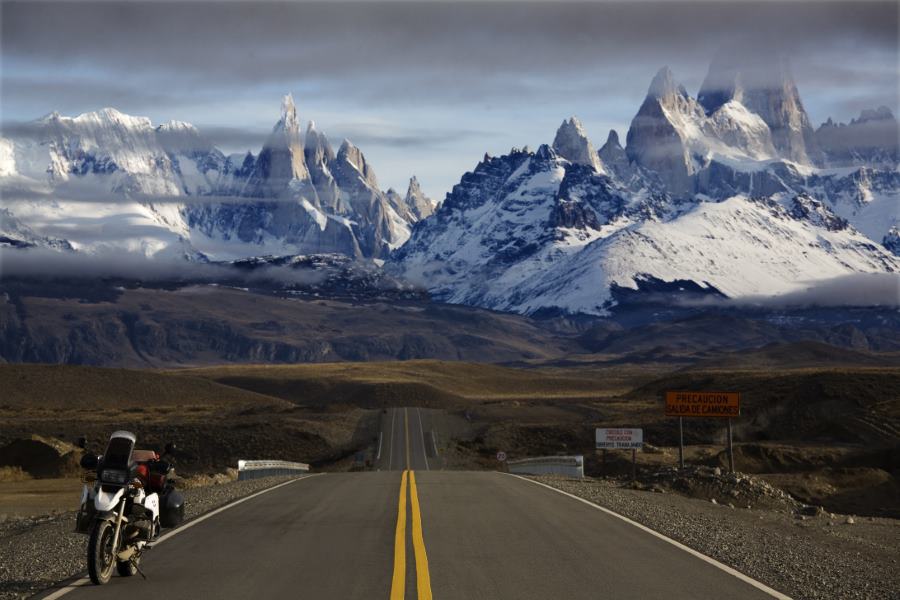

 16Likes
16Likes



























 while the guys debated our situation in Afrikaans. Nothing good could come out if this, we thought, but we were about to be proven wrong. The guy sitting right next to us at the counter put down the phone and offered us a wide smile; his wife had agreed to welcome us for the night at their place! JJ is a mechanic at a testing facility for the South African military aviation. His wife teaches English at a colored school, and they have two kids, a girl and a boy. We enjoyed each other's companies and stories so much, it was hard to put an end to the night. In the morning we exchanged contacts and regretfully said good-bye. Cheers, JJ!
while the guys debated our situation in Afrikaans. Nothing good could come out if this, we thought, but we were about to be proven wrong. The guy sitting right next to us at the counter put down the phone and offered us a wide smile; his wife had agreed to welcome us for the night at their place! JJ is a mechanic at a testing facility for the South African military aviation. His wife teaches English at a colored school, and they have two kids, a girl and a boy. We enjoyed each other's companies and stories so much, it was hard to put an end to the night. In the morning we exchanged contacts and regretfully said good-bye. Cheers, JJ! 





































































































































































































































































































































































































































 Linear Mode
Linear Mode










